RAK4270 Module Quick Start Guide
This guide covers the following topics:
- The Things Stack (TTN V3) OTAA Guide
- RAK4270 OTAA AT Commands for The Things Stack
- The Things Stack (TTN V3) ABP Guide
- RAK4270 ABP AT Commands for The Things Stack
- Chirpstack OTAA Guide
- RAK4270 OTAA AT Commands for Chirpstack
- Chirpstack ABP Guide
- RAK4270 ABP AT Commands for Chirpstack
- LoRa P2P Guide
- Updating RAK4270 FW Procedure
Prerequisites
What Do You Need?
Before going through the step in the installation guide of the RAK4270 WisDuo LPWAN Module, make sure to prepare the necessary items listed below:
Hardware Tools
- RAK4270 Module
- USB to TTL Converter
- Windows PC
Software Tools
List of Acronyms
| Acronym | Definition |
|---|---|
| DFU | Device Firmware Upgrade |
| JTAG | Joint Test Action Group |
| LoRa | Long Range |
| OTAA | Over-The-Air-Activation |
| ABP | Activation-By-Personalization (ABP) |
| TTN | The Things Network |
| TTS | The Things Stack |
Product Configuration
Interfacing with RAK4270
During the configuration of the module through the AT commands, it is possible to read the console outputs. You can connect to the console of the RAK4270 Module through the UART interface.
Connect to the RAK4270
In this document, a RAK4270 Module is used as an example case. Use a USB to TTL converter to connect to the module.
- Connect the RAK4270 to a serial port of a general-purpose computer (e.g.: USB port) using a USB to TTL module (3.3v), as shown in Figure 1.
 Figure 1: RAK4270 Module Connection
Figure 1: RAK4270 Module Connection-
Any serial communication tool can be used. But, it is recommended to use the RAK Serial Port Tool.
-
Configure the serial communication tool by selecting the proper port detected by the computer and configure the link as follows:
- Baud Rate: 115200 bauds
- Data Bits: 8 bits
- Stop Bits: 1 stop bit
- Parity: NONE
- The RAK4270 console output can now be read in the RAK serial port tool, as shown in Figure 2.
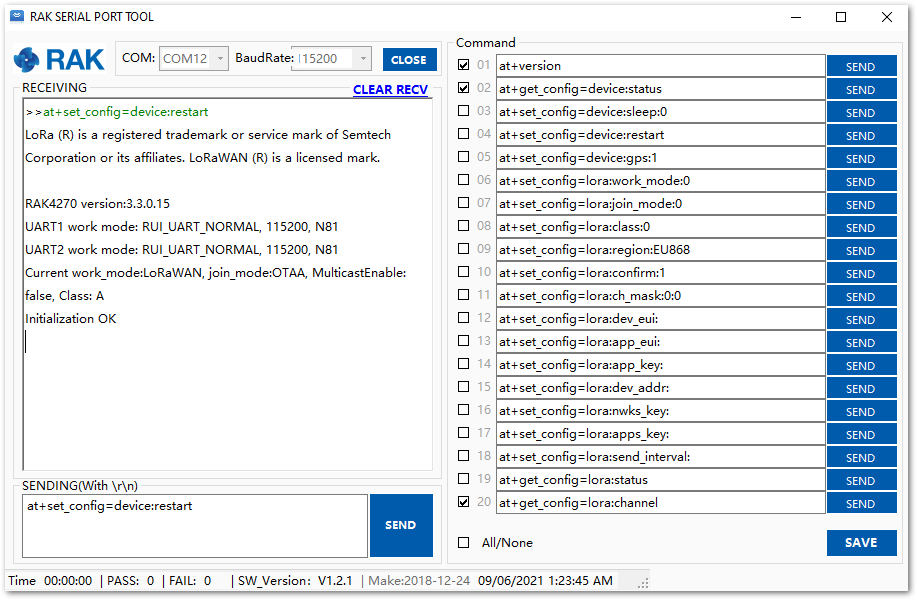 Figure 1: RAK Serial Port Tool Connected to RAK4270 Module
Figure 1: RAK Serial Port Tool Connected to RAK4270 ModuleConfiguring RAK4270
To connect the RAK4270 Module to a LoRa P2P connection or a LoRaWAN network, the module must be configured and LoRa parameters must be set by sending AT commands. You can send AT commands to the RAK4270 Module through the UART interface.
Connect the RAK4270 Module to the computer as described in the previous section. Use the serial communication tool to send commands to the RAK4270. For example, sending the at+version will return and display the current firmware version, as shown in Figure 3. More AT commands can be found in the AT Command Manual.
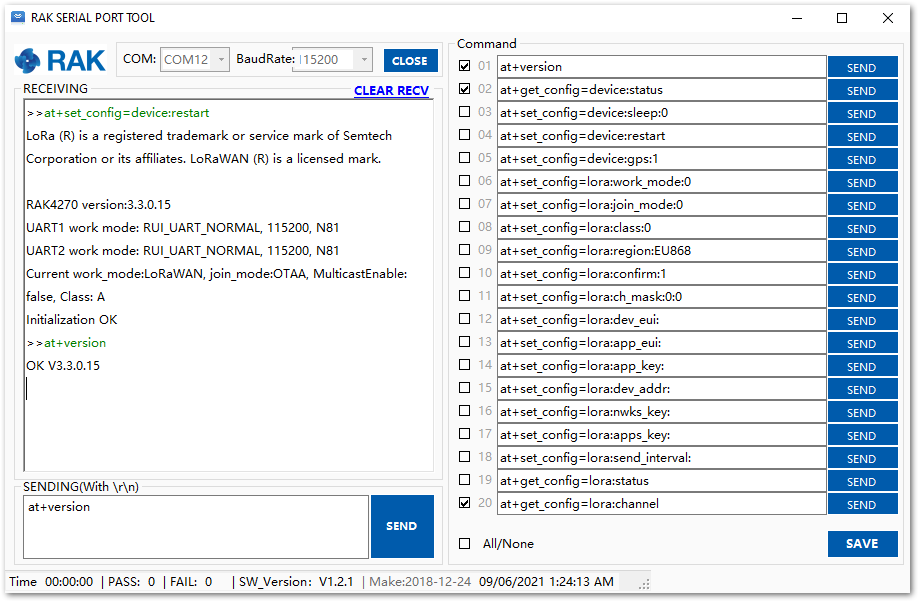 Figure 1: AT Command response
Figure 1: AT Command responseConnecting to The Things Stack (TTN V3)
This section will show how to connect the RAK4270 Module to The Things Stack (TTN V3) platform.
 Figure 1: The Things Stack diagram
Figure 1: The Things Stack diagramAs shown in Figure 4, The Things Stack is an open-source LoRaWAN Network Server suitable for global, geo-distributed public and private deployments as well as for small, local networks. The architecture follows the LoRaWAN Network Reference Model for standards compliancy and interoperability. This project is actively maintained by The Things Industries.
LoRaWAN is a protocol for low-power wide-area networks. It allows for large-scale Internet of Things deployments where low-powered devices efficiently communicate with Internet-connected applications over long-range wireless connections.
The RAK4270 Module can be part of this ecosystem as a device, and the objective of this section is to demonstrate how simple it is to send data to The Things Stack using the LoRaWAN protocol. To achieve this, the RAK4270 Module must be located inside the coverage of a LoRaWAN gateway connected to The Things Stack server.
Registration to TTN and Creating LoRaWAN Applications
The first step is to go to The Things Network platform and select a cluster, as shown in Figure 5. The Things Industries adds more clusters from time to time so select the one closes to your location. In this guide, Europe 1 is selected.
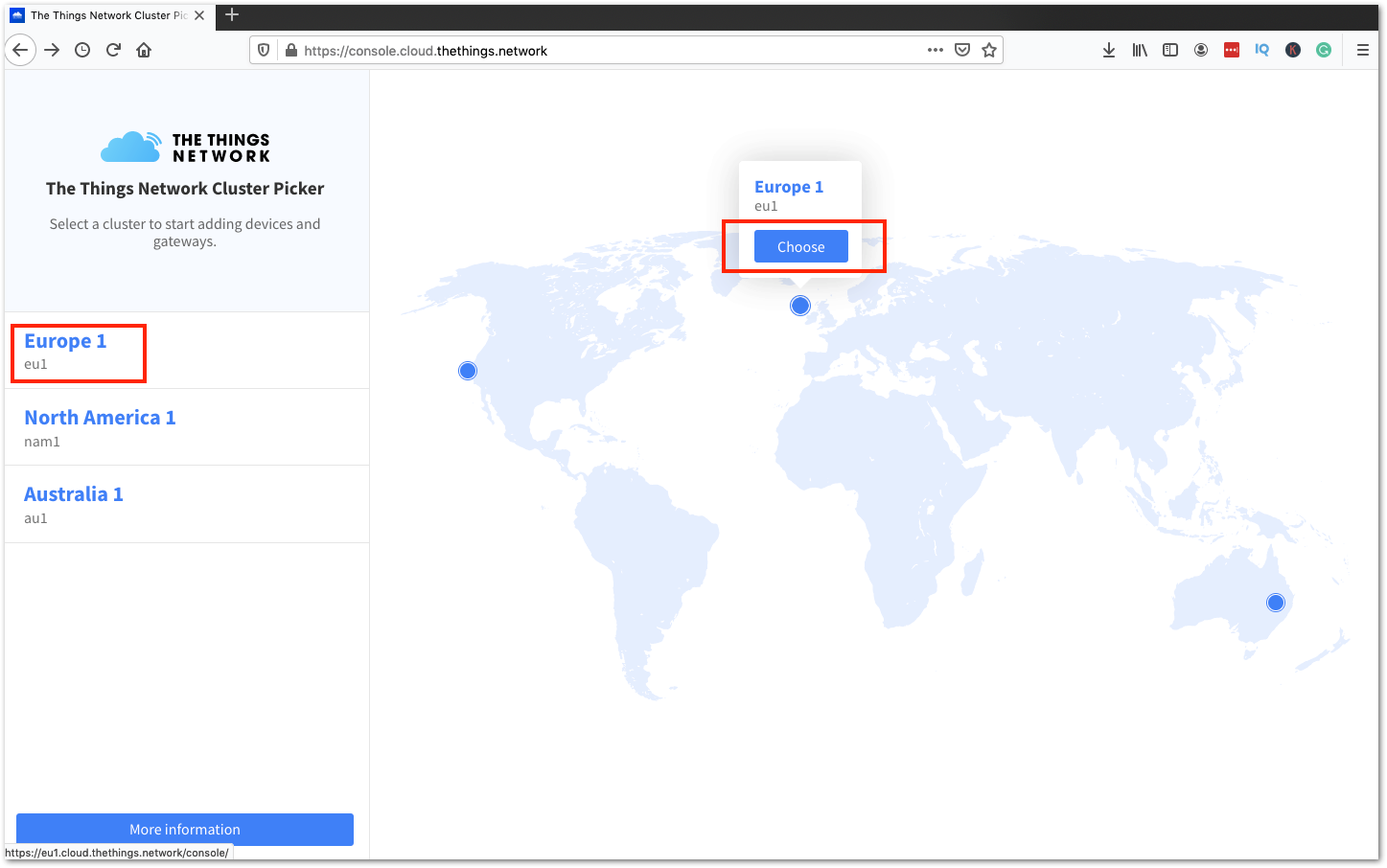 Figure 1: Selecting Cluster in TTN V3
Figure 1: Selecting Cluster in TTN V3You can use the same login credentials on the TTN V2 if you have one. If you have no account yet, you need to create one.
- To register as a new user to TTN, click on Login with The Things ID then select register on the next page, as shown in Figure 6 and Figure 7.
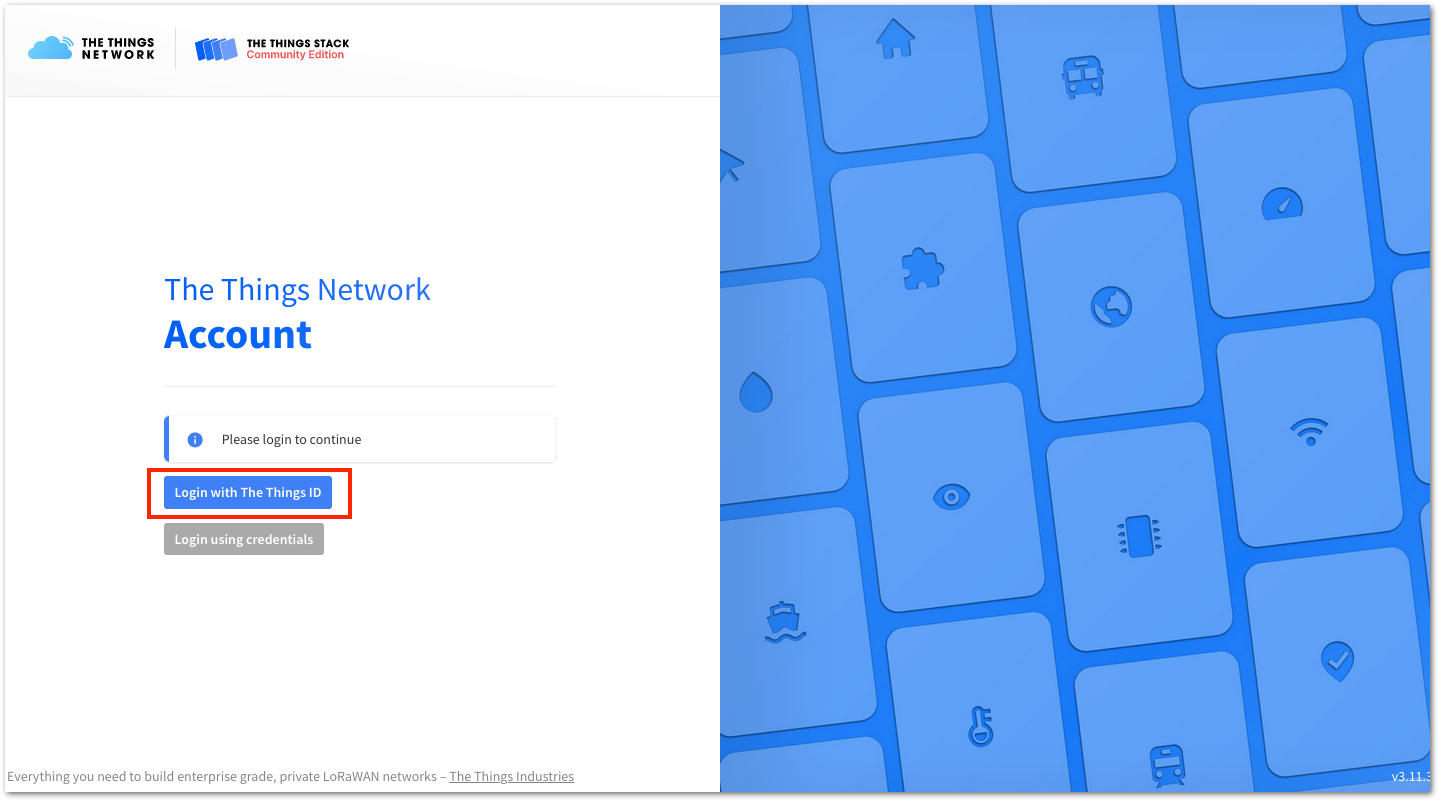 Figure 1: Login using TTN account
Figure 1: Login using TTN account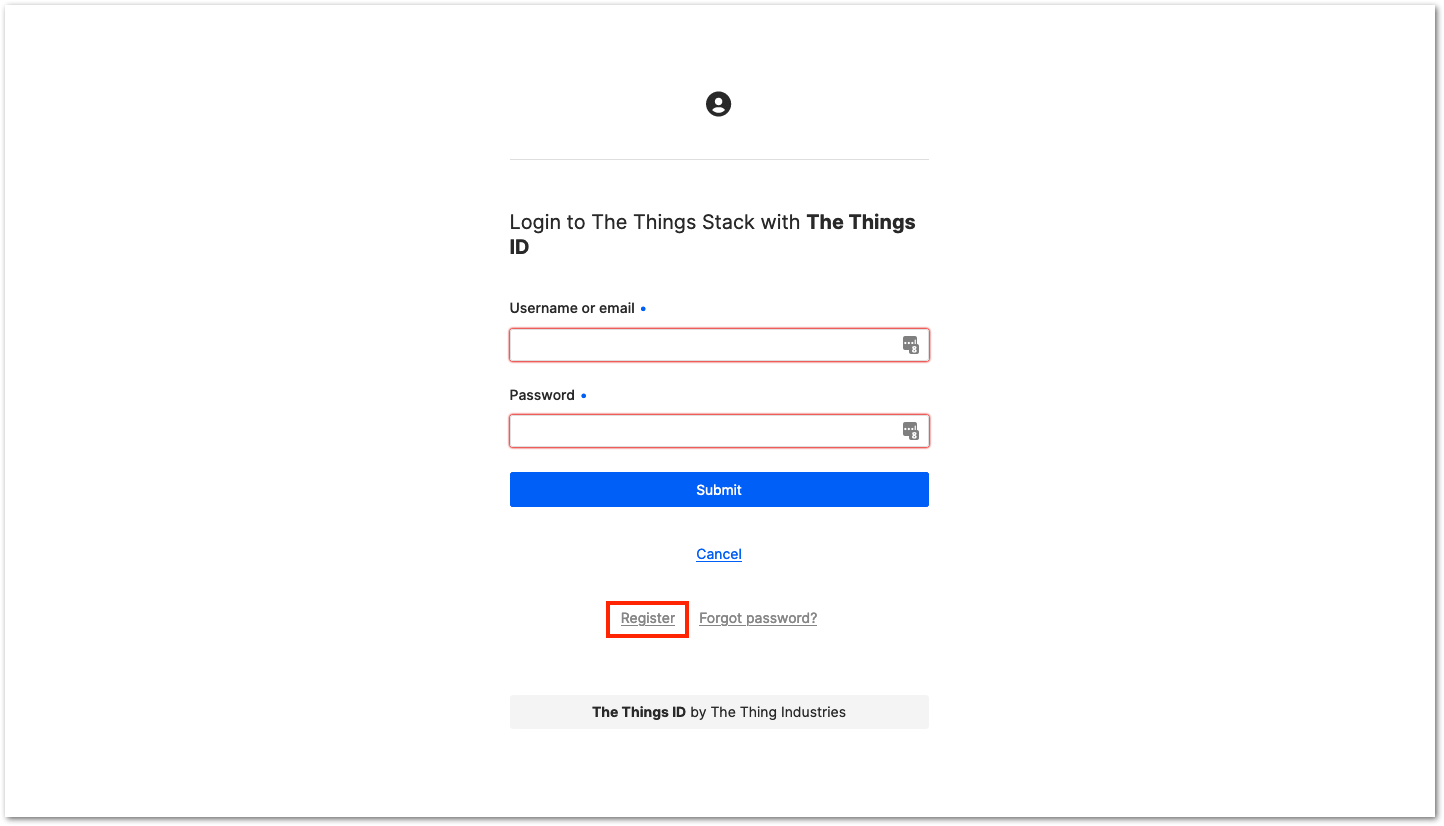 Figure 1: Registration of new account
Figure 1: Registration of new accountYou should now be on the step of creating your TTN account. Fill in all the necessary details and activate your account.
- After creating an account, you should log in to the platform using your username/email and password then click Submit, as shown in Figure 8.
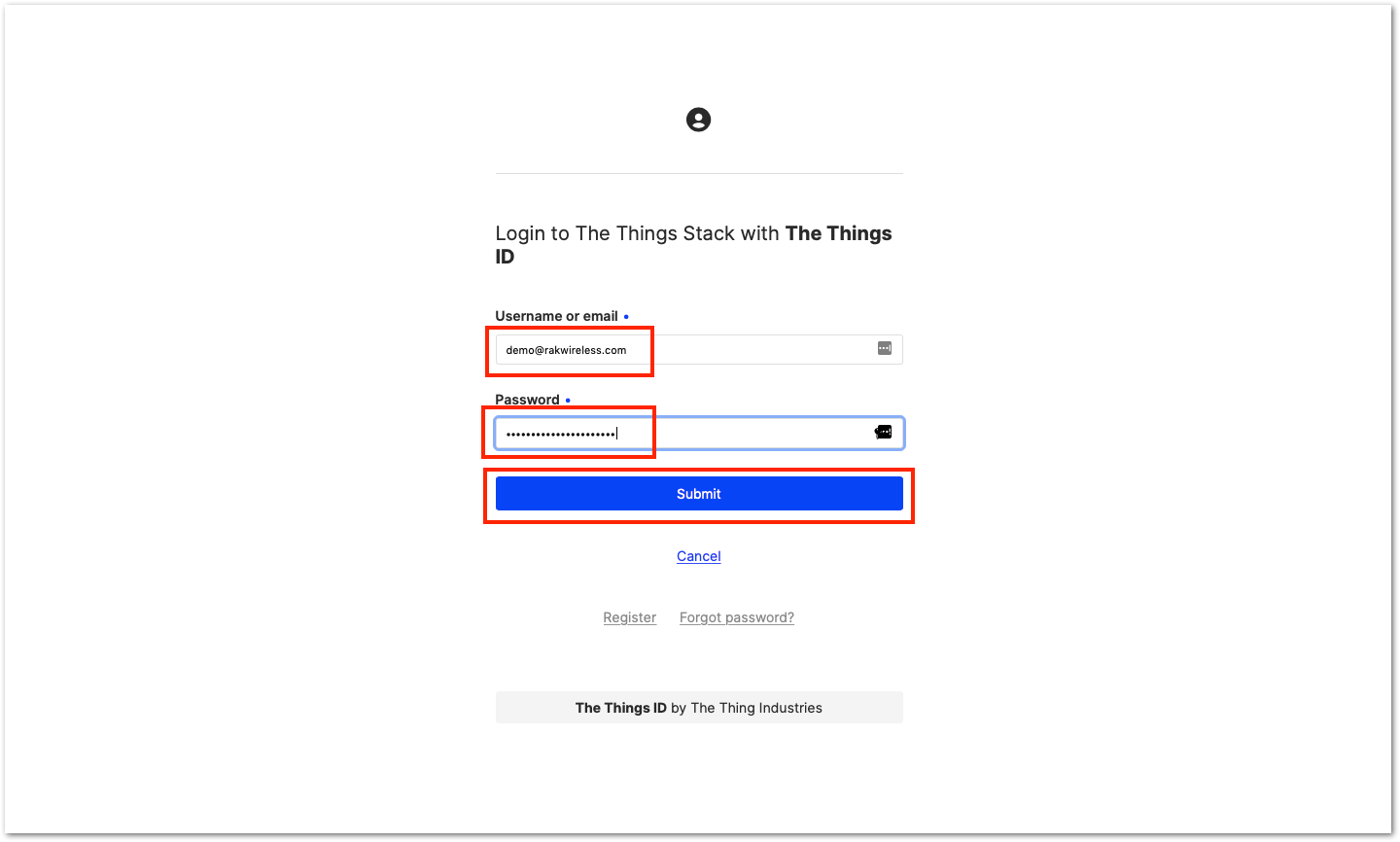 Figure 1: Logging in to TTN platform
Figure 1: Logging in to TTN platform- Click Authorize to proceed.
 Figure 1: Authorization to TTN
Figure 1: Authorization to TTN- Now that you are logged in to the platform, the next step is to create an application. Click Create an application.
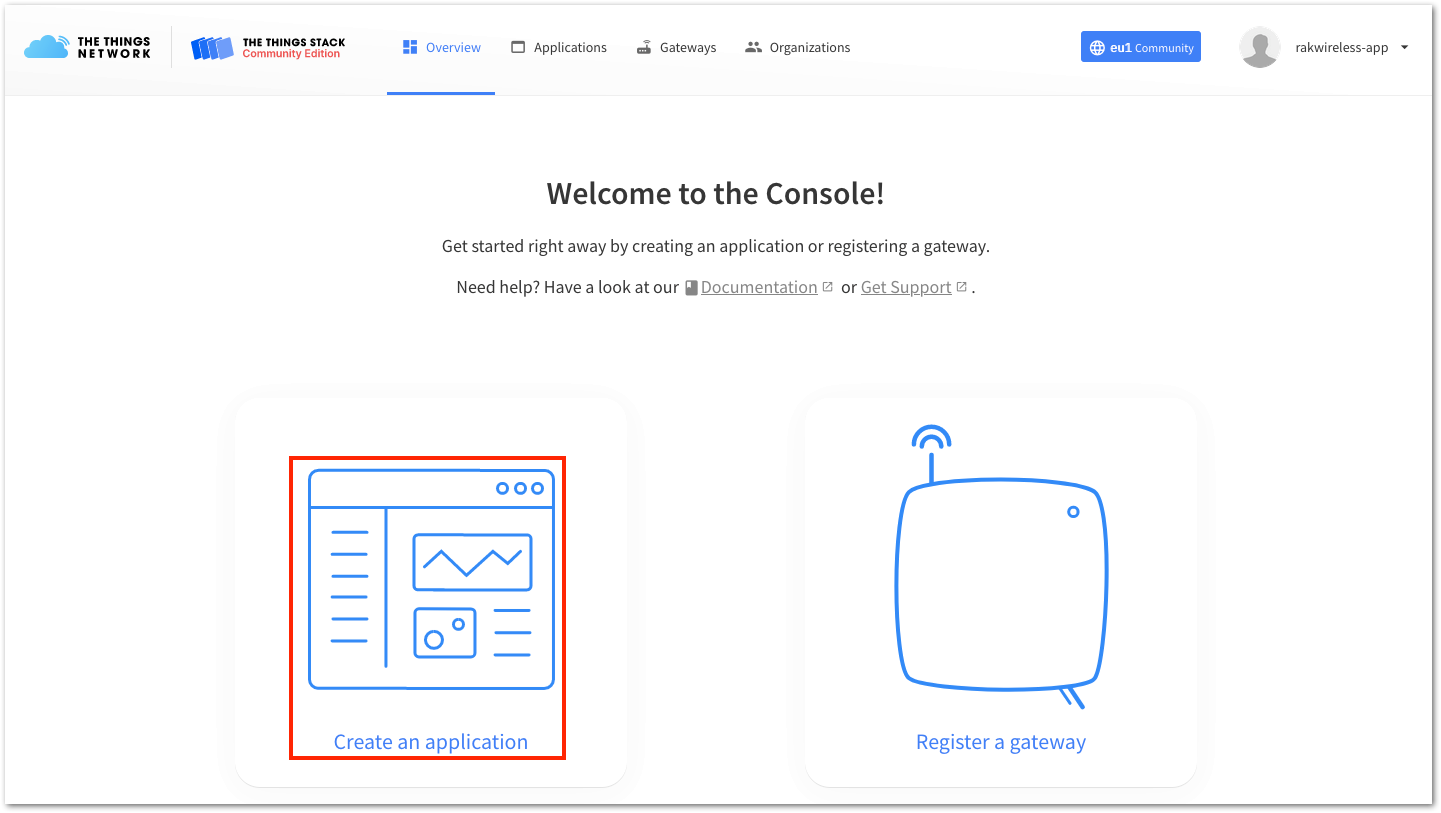 Figure 1: Creating TTN application for your LoRaWAN devices
Figure 1: Creating TTN application for your LoRaWAN devices- To have an application registered, you need to input first the specific details and necessary information about your application then click Create application.
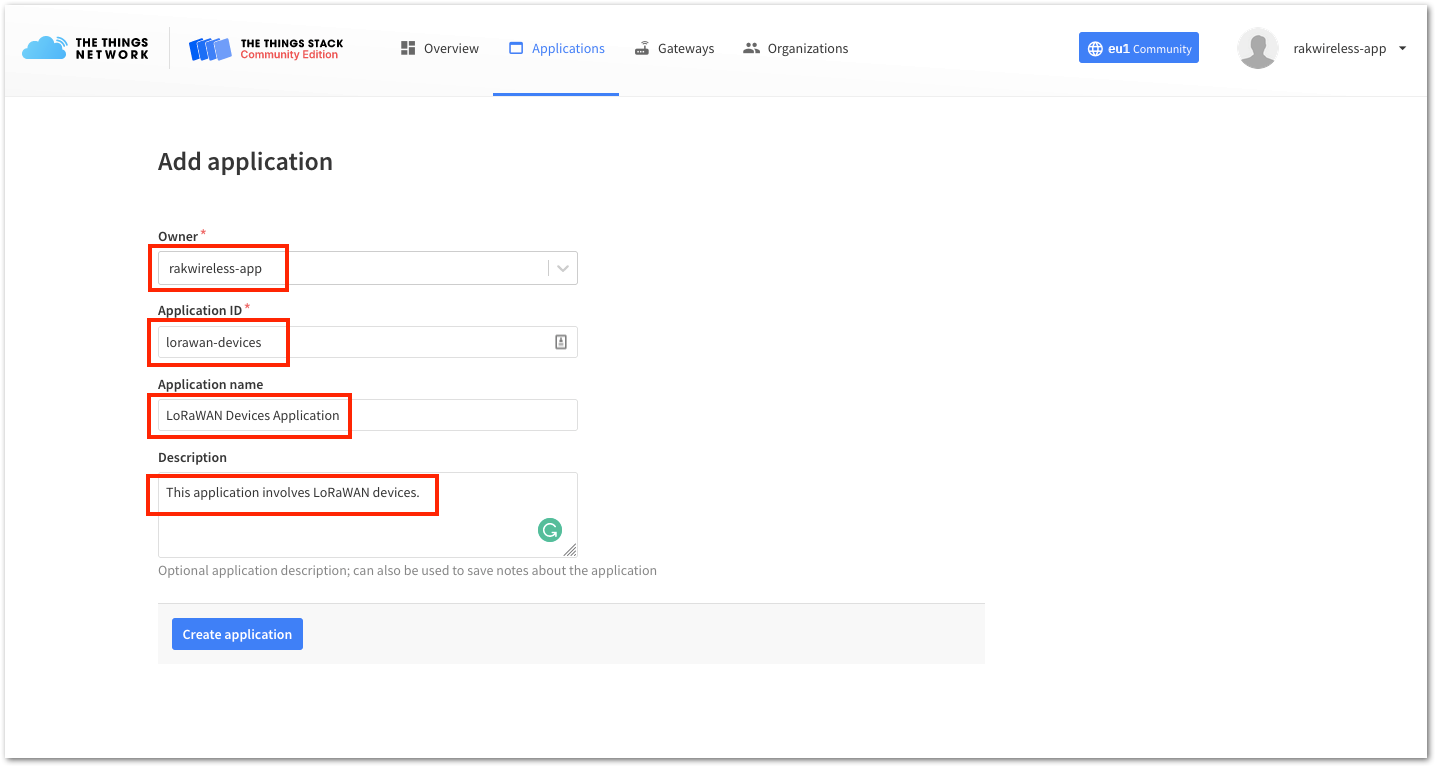 Figure 1: Details of the TTN application
Figure 1: Details of the TTN applicationIf you have no error on the previous step, you should now be on the application console page. The next step is to add end-devices to your The Things Stack application. LoRaWAN specification enforces that each end device has to be personalized and activated. There are two options on registering devices depending on the activation mode selected. Activation can be done either via Over-The-Air-Activation (OTAA) or Activation-By-Personalization (ABP).
Once you have the application in The Things Stack (TTN V3), you need to ensure that you are in coverage of a LoRaWAN gateway that is registered to The Things Stack (TTN V3) as well. Without the coverage of that LoRaWAN gateway, you cannot activate any device that you will register in your application.
RAKwireless has LoRaWAN gateways that you can connect to The Things Stack (TTN V3) if no LoRaWAN gateway coverage is available in your location.
The Things Stack OTAA Device Registration
- Go to your application console to be able to register a device. To start adding an OTAA end-device, you need to click + Add end device, as shown in Figure 12.
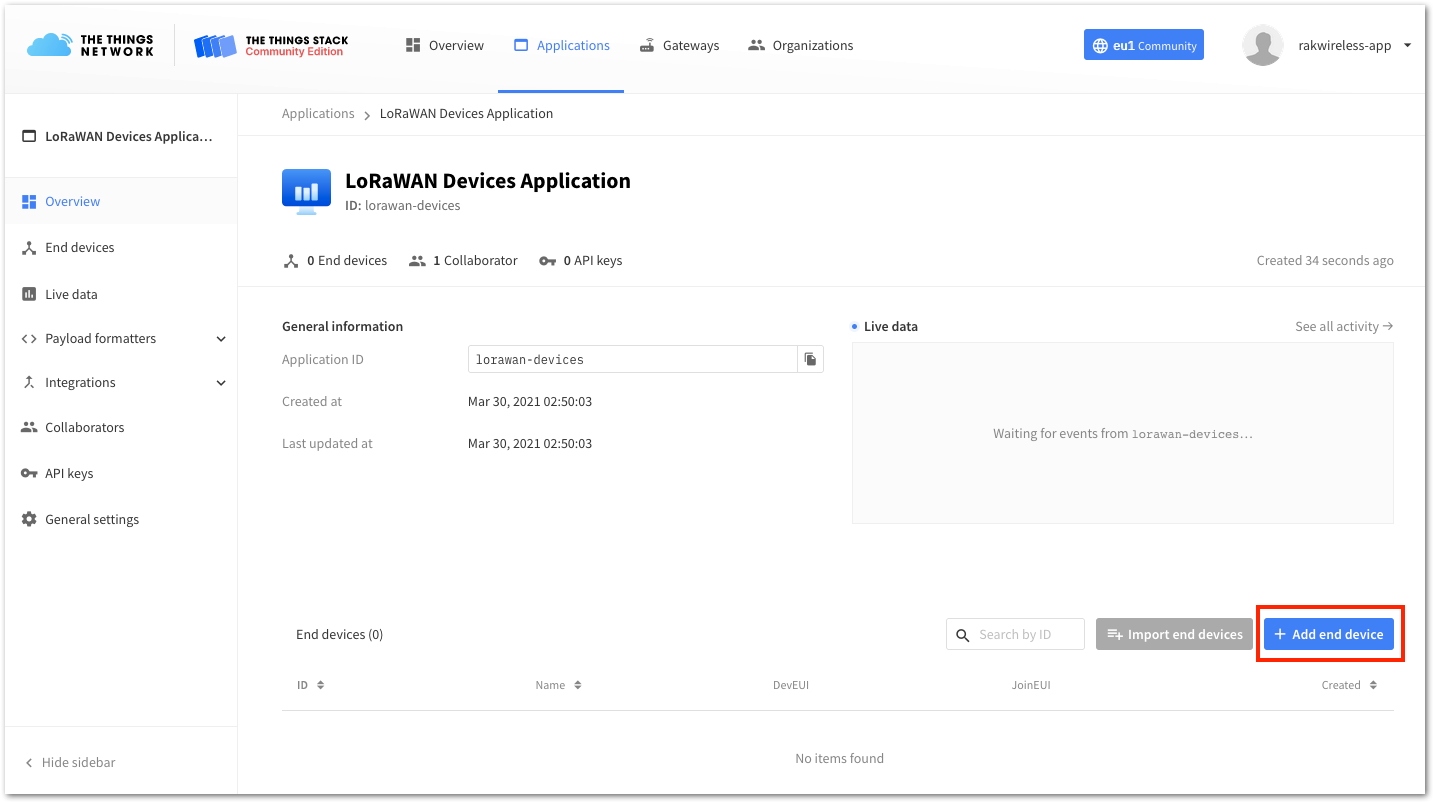 Figure 1: Add end device
Figure 1: Add end device- To register the module, you need to click first Manually then configure the activation method by selecting Over the air activation (OTAA) and compatible LoRaWAN version then click Start button, as shown in Figure 13 and Figure 14.
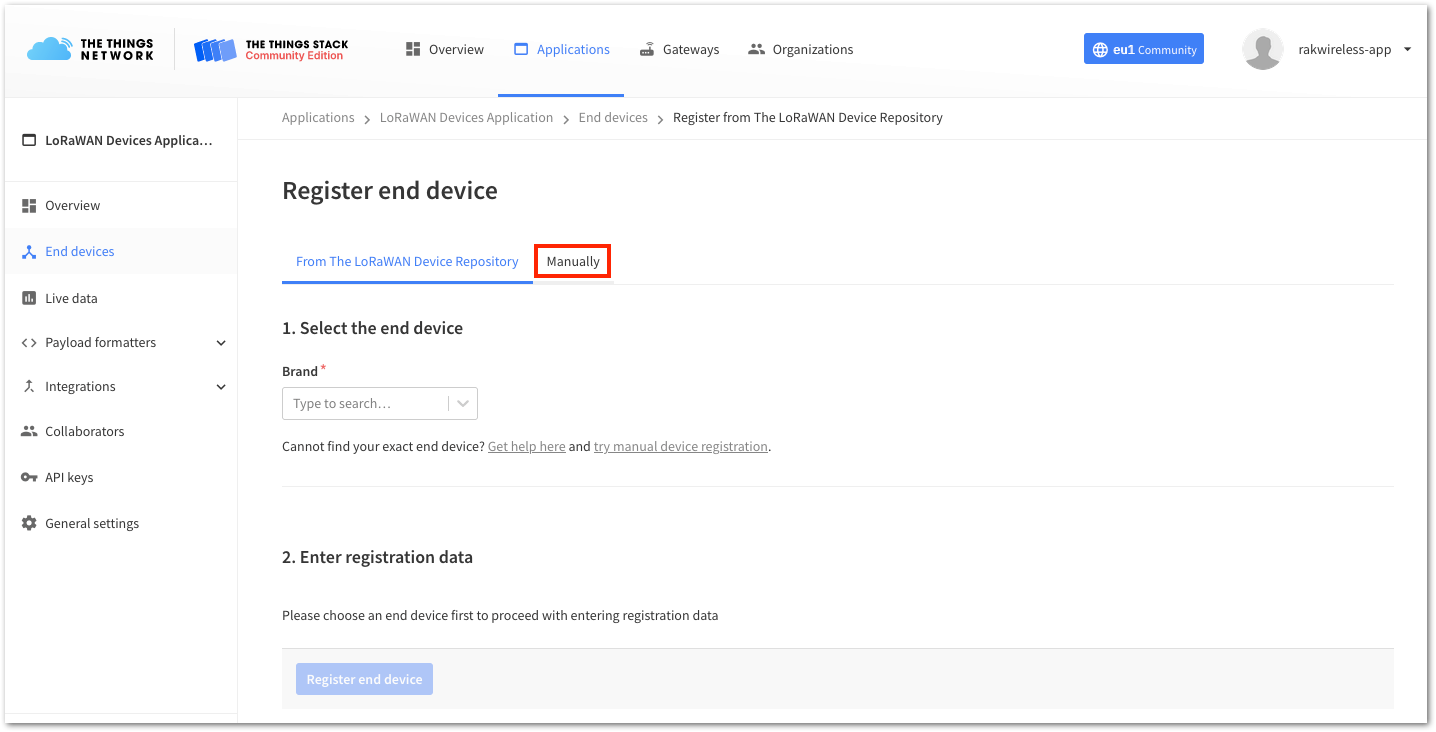 Figure 1: Manually register device to The Things Stack
Figure 1: Manually register device to The Things Stack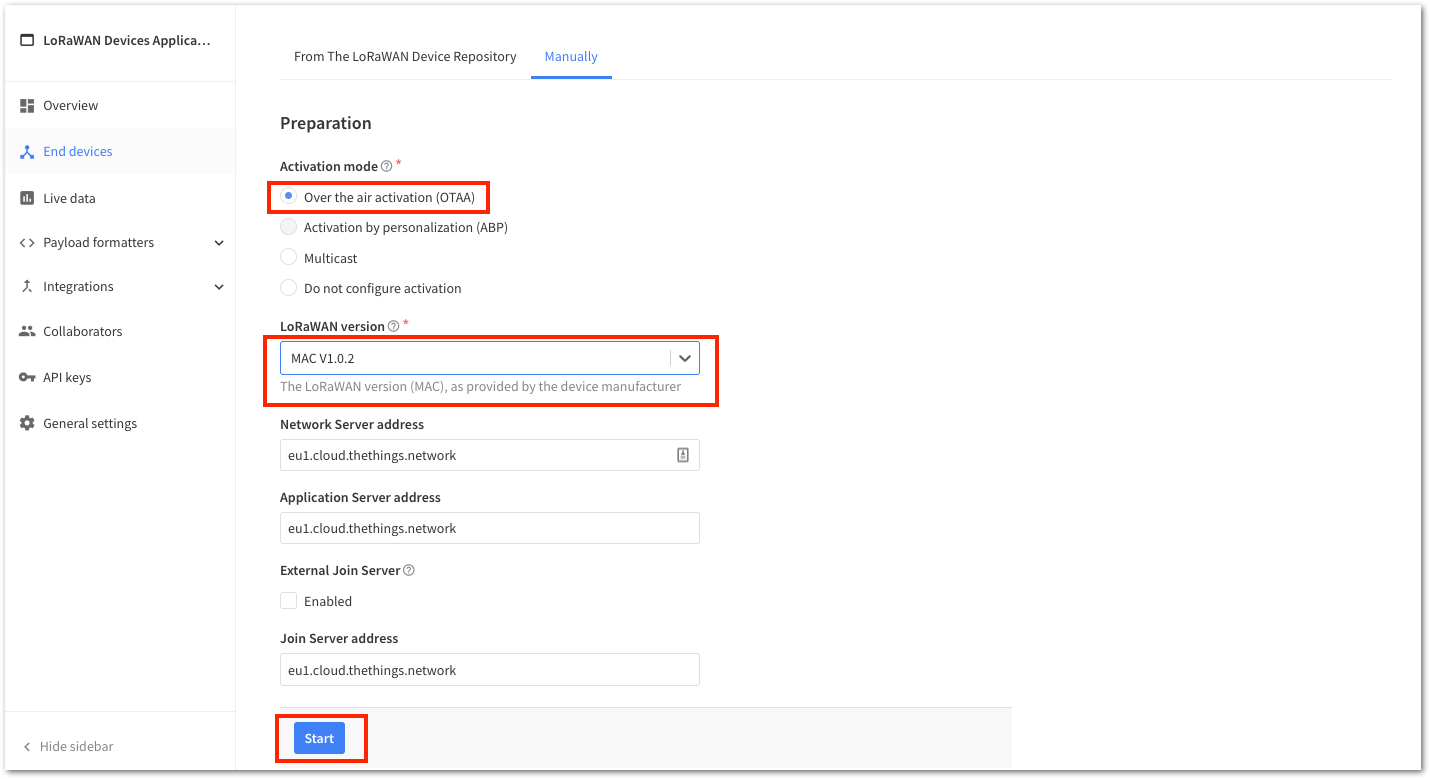 Figure 1: Device activation configuration
Figure 1: Device activation configuration- Then input a unique End device ID and EUIs (DevEUI and AppEUI), as shown in Figure 15. Check if your module has a DevEUI on sticker or QR that you can scan then use this as the device unique DevEUI.
Optionally, you can add a more descriptive End device name and End device description about your device.
- After putting all the details, click Network layer settings to proceed to the next step.
It is advisable to use a meaningful End device ID, End device name, and End device description that will match your device purpose. The End device ID rak-device is for illustration purposes only.
 Figure 1: OTAA Device Information
Figure 1: OTAA Device Information- Next step is to set up Frequency plan, compatible Regional Parameter version, and LoRaWAN class supported. Then you can click Join settings
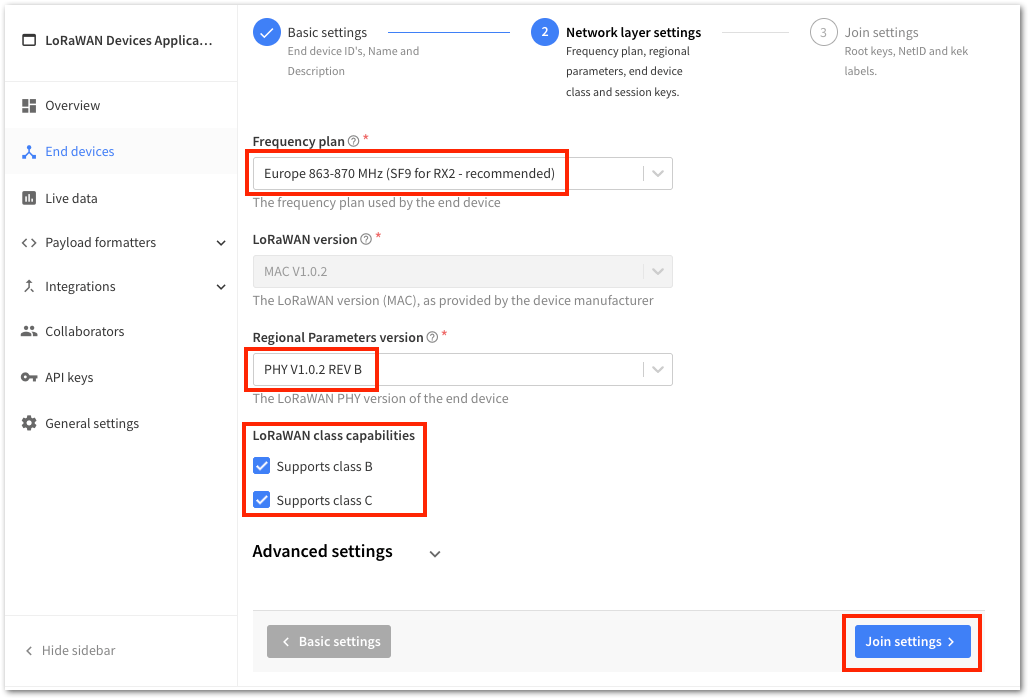 Figure 1: OTAA Configuration
Figure 1: OTAA Configuration- The last step in the registration of a new OTAA end device is the configuration of the AppKey. To get the AppKey, you must click the generate button. Then click Add end device to finish your new device registration.
 Figure 1: OTAA AppKey generation and device registration
Figure 1: OTAA AppKey generation and device registrationYou should now be able to see the device on The Things Stack console after you fully registered your device, as shown in Figure 18.
The AppEUI, DevEUI, and AppKey are the parameters that you will need to activate your LoRaWAN end device via OTAA. The AppKey is hidden by default for security reasons, but you can easily show it by clicking the show button. You can also copy the parameters quickly using the copy button.
The three OTAA parameters on The Things Stack device console are MSB by default.
These parameters are always accessible on the device console page, as shown in Figure 18.
 Figure 1: OTAA device successfully registered to The Things Stack
Figure 1: OTAA device successfully registered to The Things StackRAK4270 OTAA Configuration for The Things Stack
The RAK4270 Module supports a series of AT commands to configure its internal parameters and control the functionalities of the module. To set up the RAK4270 Module to join The Things Stack using OTAA, start by connecting the RAK4270 Module to the Computer (see Figure 1) and open the RAK Serial Port Tool. Wait for the communication to start. It is recommended to test the serial communication and verify the current configuration by sending either of these two AT commands:
at+set_config=device:restart
at+version
 Figure 1: AT Command response
Figure 1: AT Command responseAs an example, these are the list of the parameters you need to configure in RAK4270:
- LoRa join mode: OTAA
- LoRa class: Class A
- LoRa region: EU868
- Device EUI: 1133557799224466
- Application EUI: 1000000000000009
- Application Key: 04FA4E626EF5CF227C969601176275C2
- Set the LoRa join mode to OTAA.
at+set_config=lora:join_mode:0
- Set the LoRa class to Class A.
at+set_config=lora:class:0
- Set the frequency/region to EU868.
- Refer to the RAK4270 Module Datasheet for the list of supported frequencies.
at+set_config=lora:region:EU868
- Set the Device EUI.
at+set_config=lora:dev_eui:1133557799224466
- Set the Application EUI.
All zero value Application EUI at+set_config=lora:app_eui:0000000000000000 is not supported and will return error.
at+set_config=lora:app_eui:1000000000000009
- Set the Application Key.
at+set_config=lora:app_key:04FA4E626EF5CF227C969601176275C2
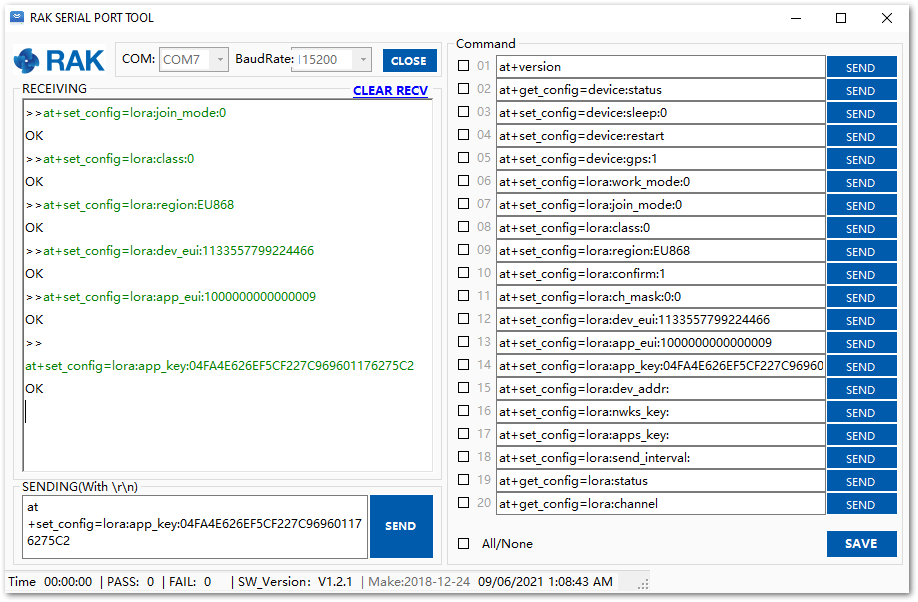 Figure 1: Configuring LoRa Parameters
Figure 1: Configuring LoRa ParametersAfter configuring all the parameters, you need to reset your RAK4270 Module to save the parameters.
- After resetting, join in OTAA mode.
at+join
After 5 or 6 seconds, if the request was successfully received by a LoRa gateway, then you should see the messages shown in Figure 21.
- Try to send a message from the RAK4270 Module.
at+send=lora:2:1234567890
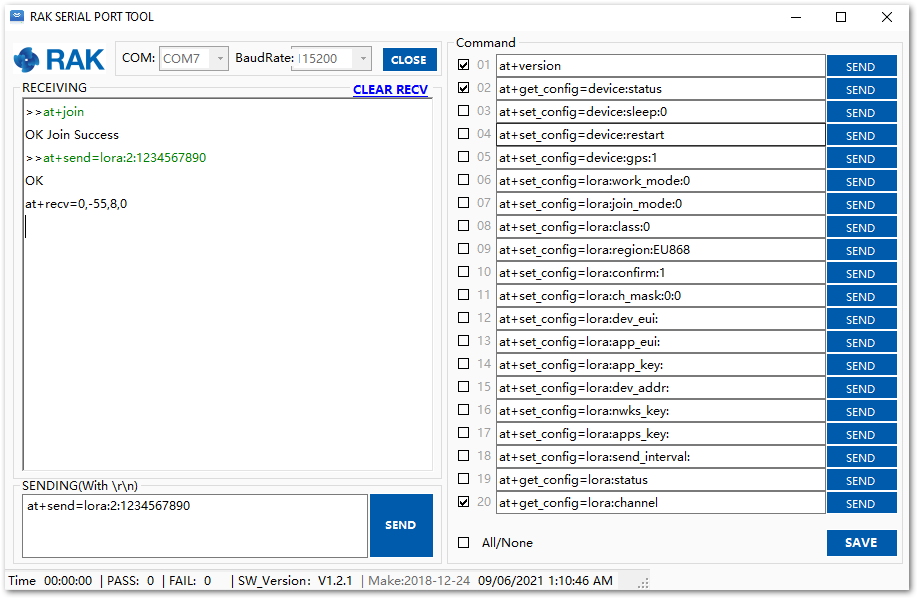 Figure 1: OTAA Test Sample Data Sent via RAK Serial Port Tool
Figure 1: OTAA Test Sample Data Sent via RAK Serial Port ToolYou can see the data sent by the RAK4270 Module on The Things Stack platform, as shown in Figure 22.
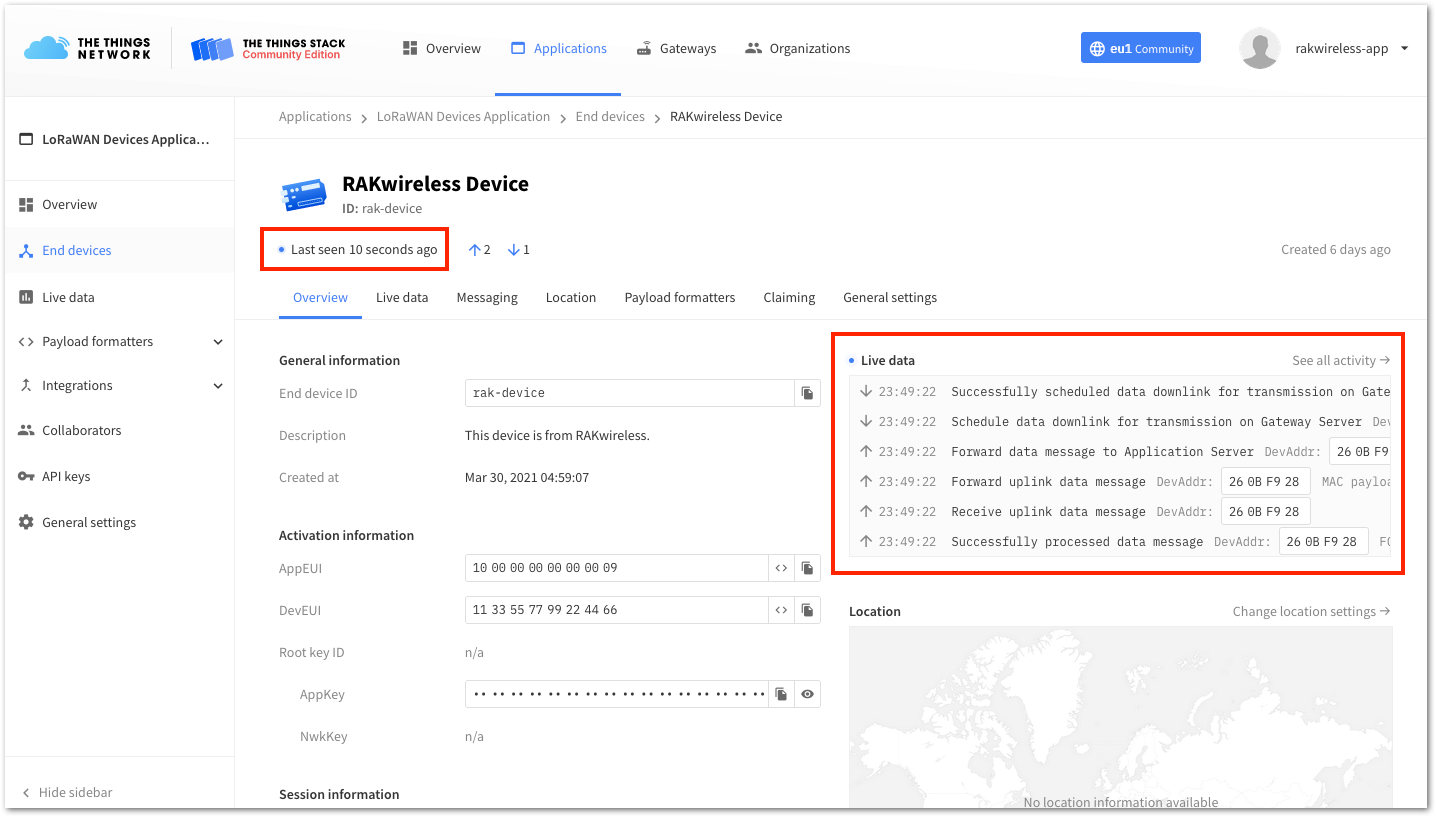 Figure 1: OTAA Test Sample Data Sent Viewed in The Things Stack
Figure 1: OTAA Test Sample Data Sent Viewed in The Things StackThe Things Stack ABP Device Registration
- To register an ABP device, go to your application console and select the application where you want your device to be added. Then click + Add end device, as shown in Figure 23.
 Figure 1: Add end device
Figure 1: Add end device- To register the module, you need to click first Manually then configure the activation method by selecting Activation by personalization (ABP), compatible LoRaWAN version and click Start button, as shown in Figure 24 and Figure 25.
 Figure 1: Add end device
Figure 1: Add end device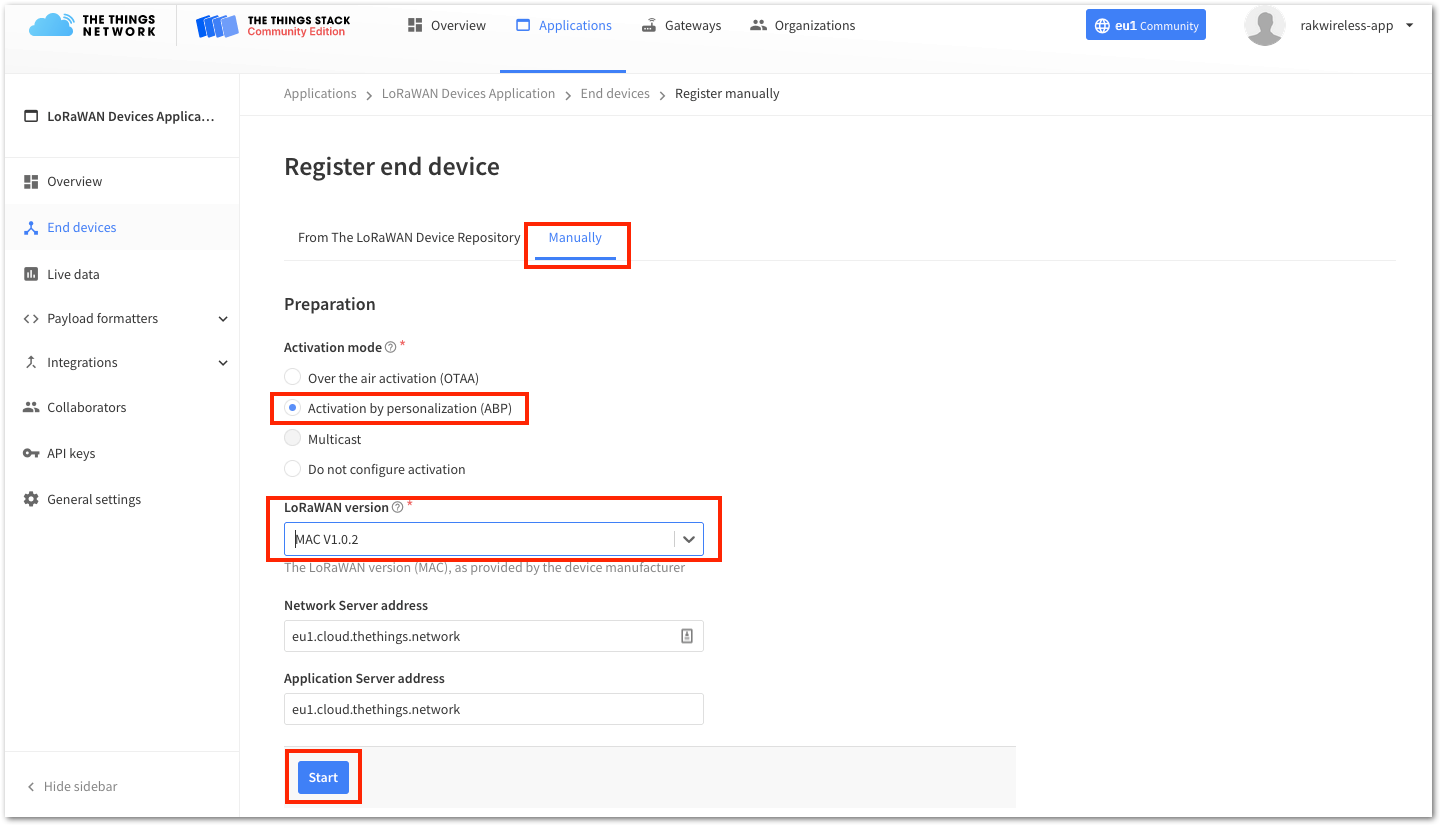 Figure 1: Manually register device to The Things Stack
Figure 1: Manually register device to The Things Stack- At this step, input a unique End device ID and DevEUI, as shown in Figure 26. Check if your module has a DevEUI on sticker or QR that you can scan then use this as the device unique DevEUI.
Optionally, you can add a more descriptive End device name and End device description about your device.
- After putting all the details, click Network layer settings to proceed to the next step.
It is advisable to use a meaningful End device ID, End device name, and End device description that will match your device purpose. The End device ID rak-device-abp is for illustration purposes only.
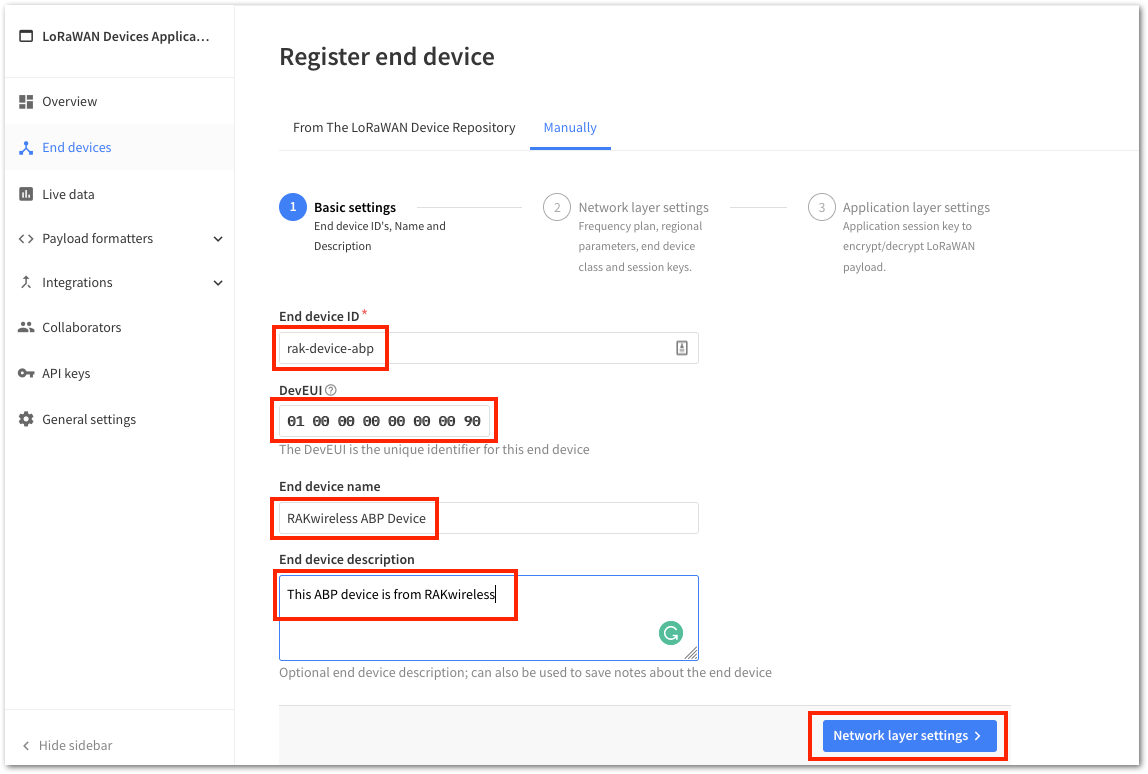 Figure 1: Device Information
Figure 1: Device Information- Next step is to set up Frequency plan, compatible Regional Parameter version, and LoRaWAN class supported. In an ABP device, you also need to generate Device Address and NwkSKey (Network Session Keys). Then you can click Application layers settings.
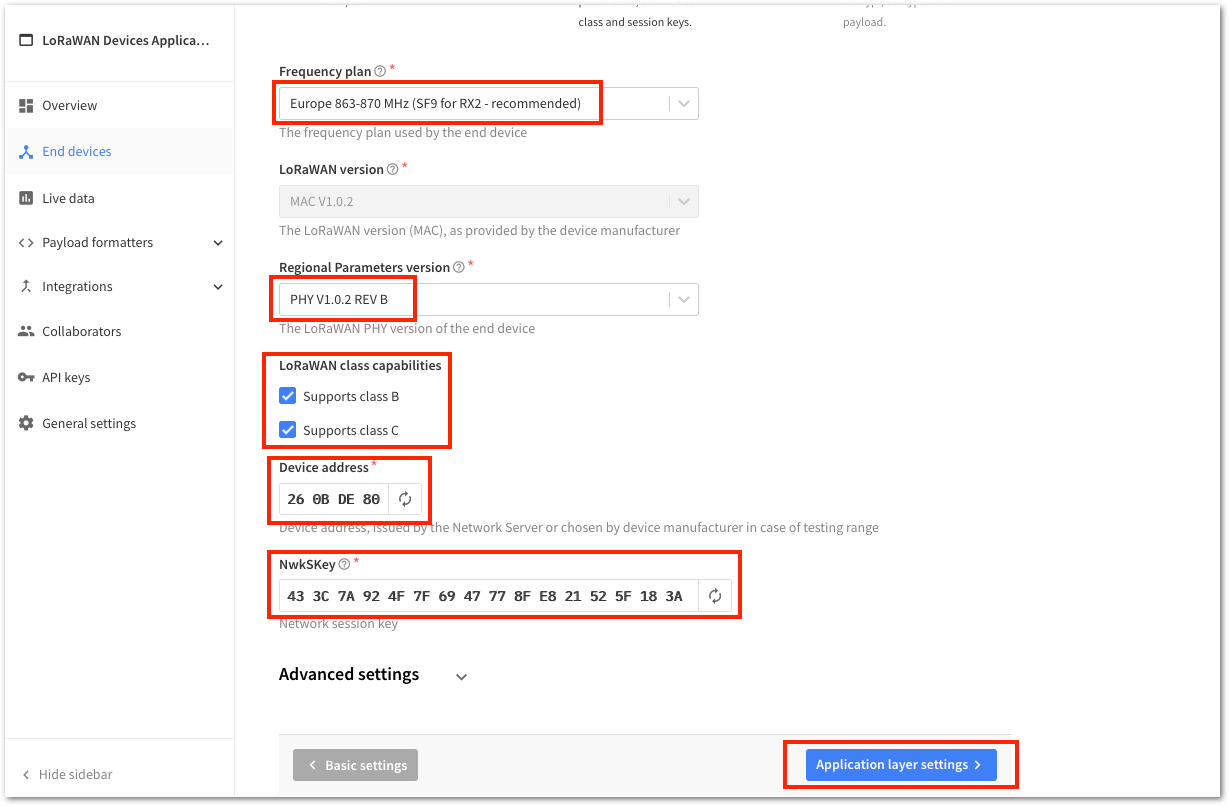 Figure 1: ABP Configuration in The Things Stack
Figure 1: ABP Configuration in The Things Stack- The last step in the registration of a new ABP end device is the configuration of the AppSKey. To get the AppSKey, you must click the generate button. Then click Add end device to finish your new device registration.
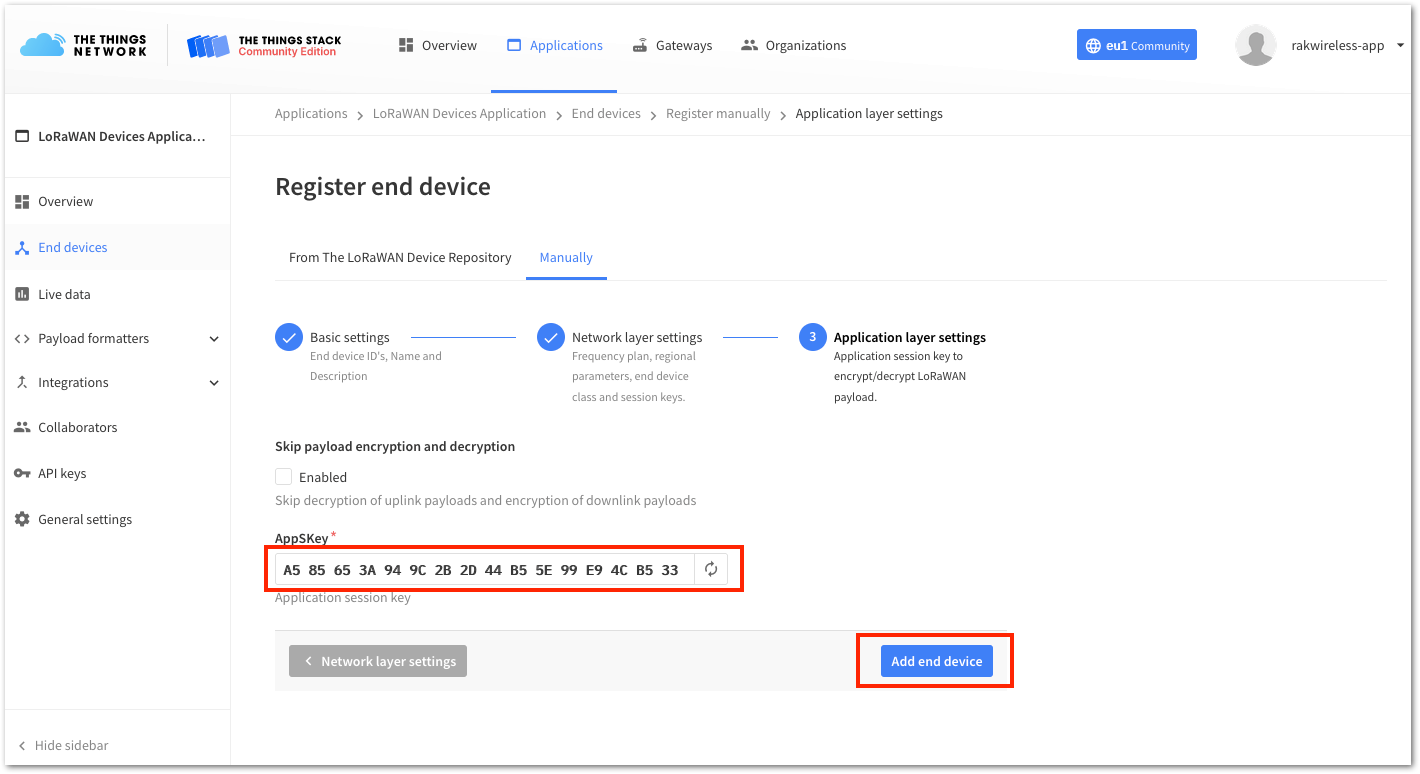 Figure 1: ABP Configuration in The Things Stack
Figure 1: ABP Configuration in The Things StackYou should now be able to see the device on The Things Stack console after you fully registered your device, as shown in Figure 29.
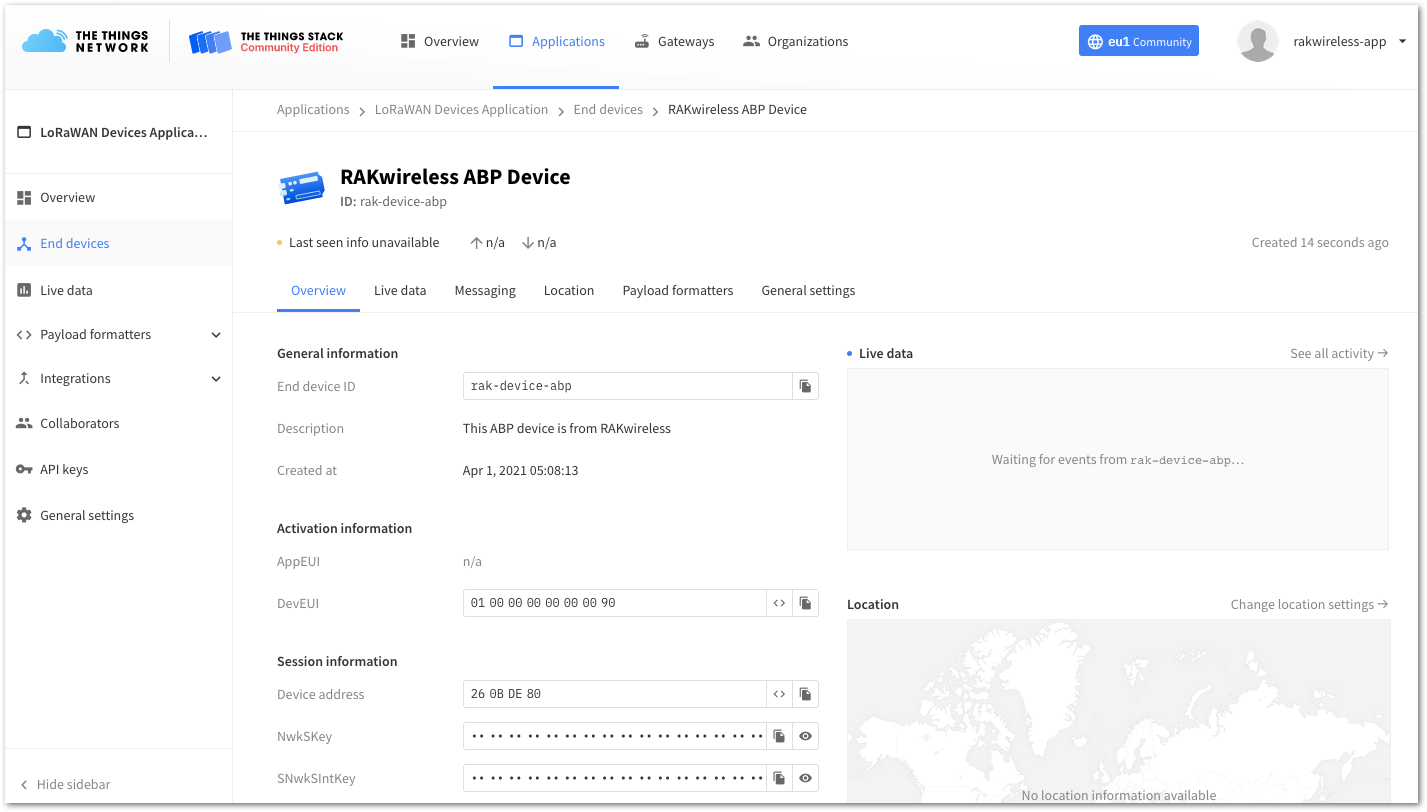 Figure 1: RAK4270 registered at The Things Stack
Figure 1: RAK4270 registered at The Things StackRAK4270 ABP Configuration for The Things Stack
To set up the RAK4270 Module to join The Things Stack using ABP, start by connecting the RAK4270 Module to the Computer (see Figure 1) and open the RAK Serial Port Tool. It is recommended to test the serial communication by sending either of these two AT commands:
at+set_config=device:restart
at+version
 Figure 1: AT Command response
Figure 1: AT Command responseAs an example, these are the list of the parameters you need to configure in RAK4270:
- LoRa join mode: ABP
- LoRa class: Class A
- LoRa region: EU868
- Device address: 260BDE80
- Network Session Key: 433C7A924F7F6947778FE821525F183A
- Application Session Key: A585653A949C2B2D44B55E99E94CB533
- Set the LoRa join mode to ABP.
at+set_config=lora:join_mode:1
- Set the LoRa class to Class A.
at+set_config=lora:class:0
- Set the frequency/region to EU868.
- Refer to the RAK4270 Module Datasheet for the list of supported frequencies.
at+set_config=lora:region:EU868
- Set the Device Address.
at+set_config=lora:dev_addr:260BDE80
- Set the LoRa Network Session Key.
at+set_config=lora:nwks_key:433C7A924F7F6947778FE821525F183A
- Set the LoRa Application Session Key.
at+set_config=lora:apps_key:A585653A949C2B2D44B55E99E94CB533
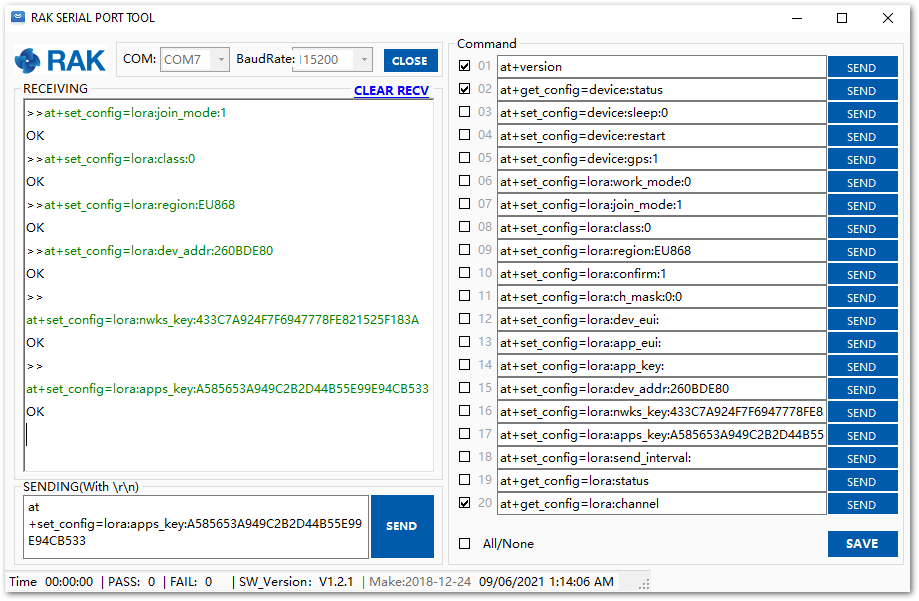 Figure 1: AT Command for ABP LoRa parameters via RAK Serial Port Tool
Figure 1: AT Command for ABP LoRa parameters via RAK Serial Port ToolAfter configuring all the parameters, you need to reset the RAK4270 Module to save the parameters.
- After resetting, join in ABP mode.
at+join
By using the ABP mode in LoRaWAN, it doesn’t require to join a network before sending a LoRaWAN package. But to keep the consistency of internal states of the firmware of the RAK4270 Module, it is still required to send the at+join command in the ABP mode. This time, the firmware should reply almost immediately with an “OK”.
- Try to send data from the RAK4270 to The Things Network in ABP mode.
at+send=lora:2:1234567890
 Figure 1: ABP Test Sample Data Sent via RAK Serial Port Tool
Figure 1: ABP Test Sample Data Sent via RAK Serial Port ToolYou can see the data sent by the RAK4270 Module on The Things Stack device console Live data section and the Last seen info should be few seconds ago.
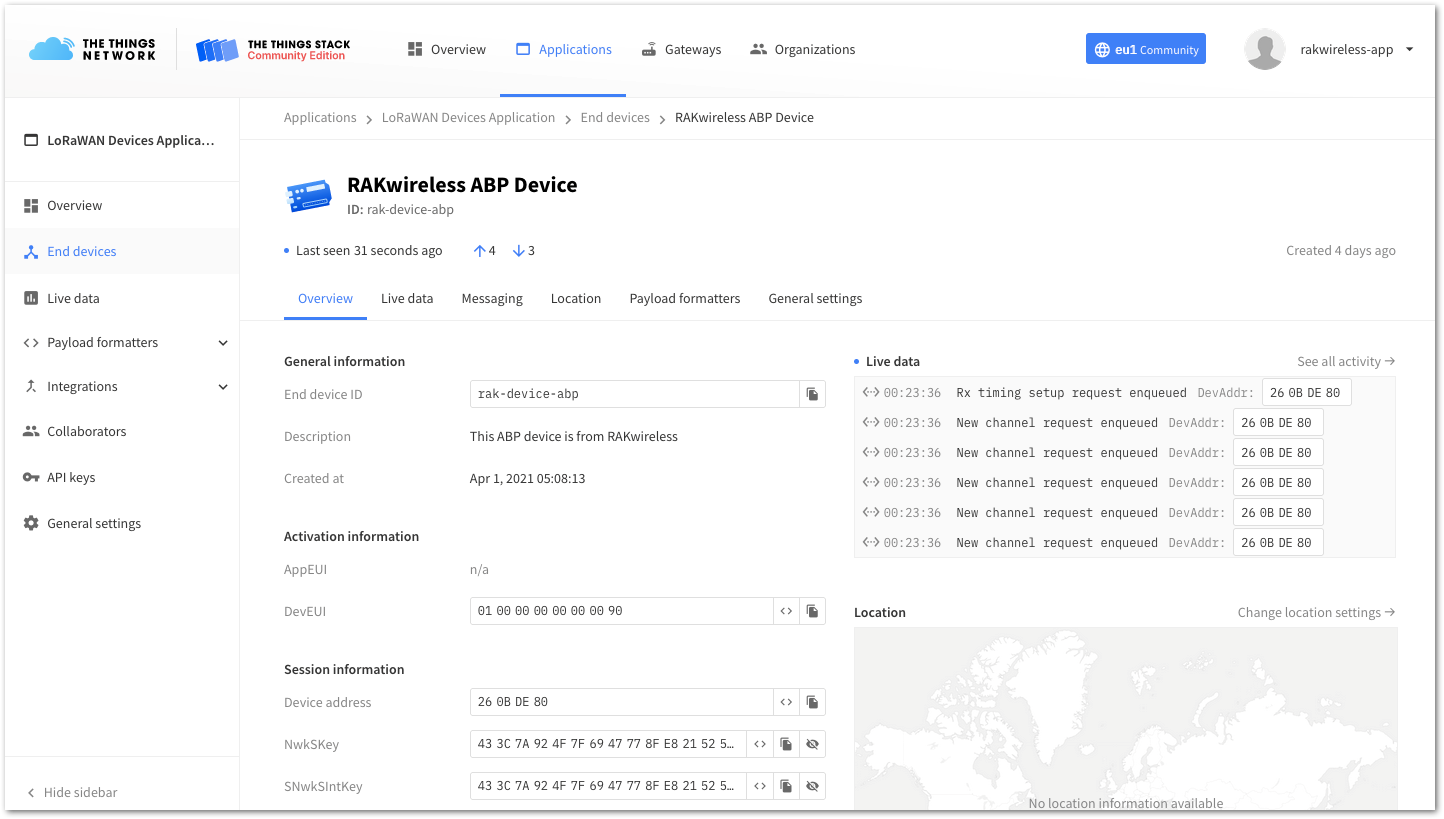 Figure 1: OTAA Test Sample Data Sent Viewed in The Things Stack
Figure 1: OTAA Test Sample Data Sent Viewed in The Things StackConnecting with ChirpStack
In this section, a practical exercise will be performed to show how to connect the RAK4270 Module to the ChirpStack platform.
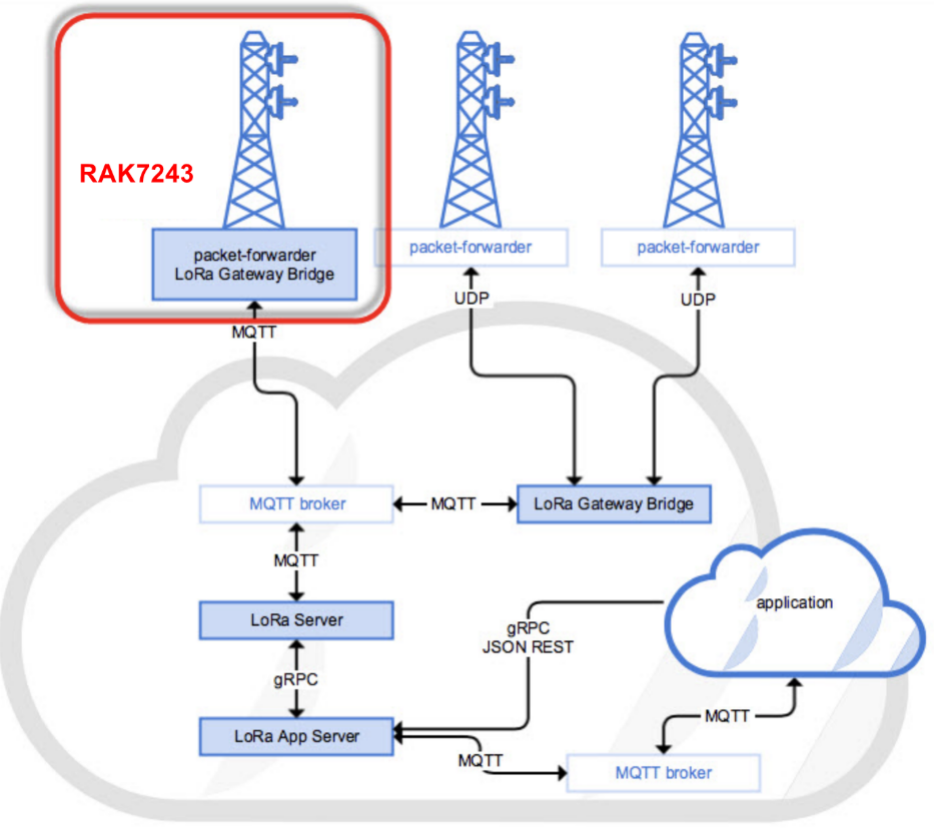 Figure 1: RAK4270 Module in the Context of the ChirpStack Platform
Figure 1: RAK4270 Module in the Context of the ChirpStack PlatformThe ChirpStack, previously known as the LoRaServer project, provides open-source components for building LoRaWAN networks. Like the case of TTN, the RAK4270 Module is located in the periphery and transmits the data to the backend servers through a LoRa gateway. Learn more about ChirpStack.
In this document, it is assumed that you are using RAK Gateway and its built-in ChirpStack or RAK cloud testing ChirpStack. Also, the gateway with the ChirpStack must be configured successfully. For further information, check the RAK documents for more details.
In this section, you need the following requirements:
- Have ChirpStack online gateway, the frequency band of the nodes should be consistent with the frequency band of the gateway in use.
- The RAK Serial Port Tool provided by RAK
- RAK4270 Module
The frequency band used in the test is EU868, use the high-frequency version of RAK4270.
Before you start, you must choose which mode you are going to use, whether in OTAA or ABP mode, to register the device to the network server.
Sign up and loginLogin to the ChirpStack server using your account and password.
Create a New Application
- Go to the Application section, as shown in Figure 35.
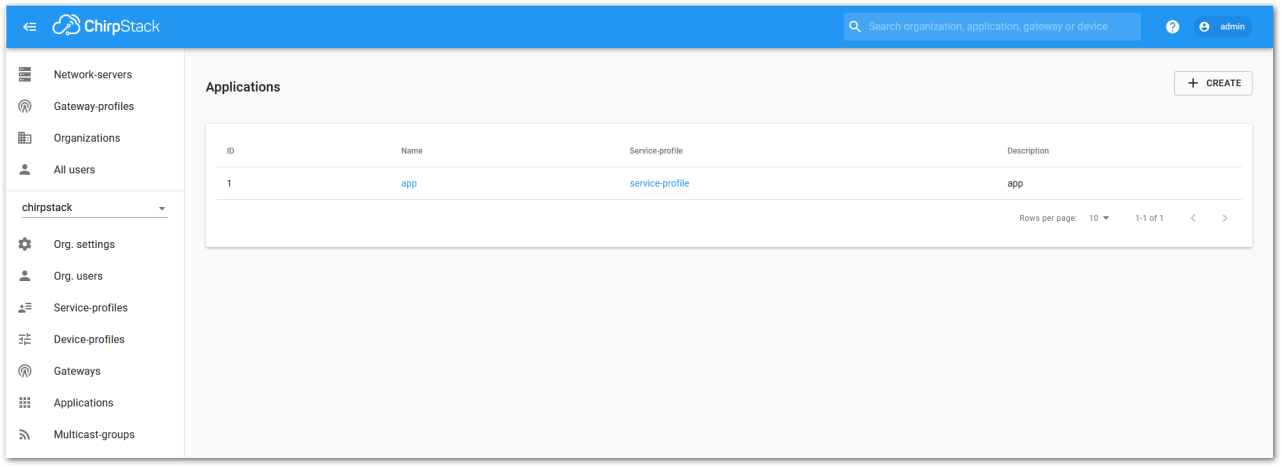 Figure 1: Application Section
Figure 1: Application Section- By default, you should create a new Application, although you can reuse the existing ones. For this setup, create a new Application by clicking on the “CREATE” button and filling the required parameters, as shown in Figure 36 and Figure 37.
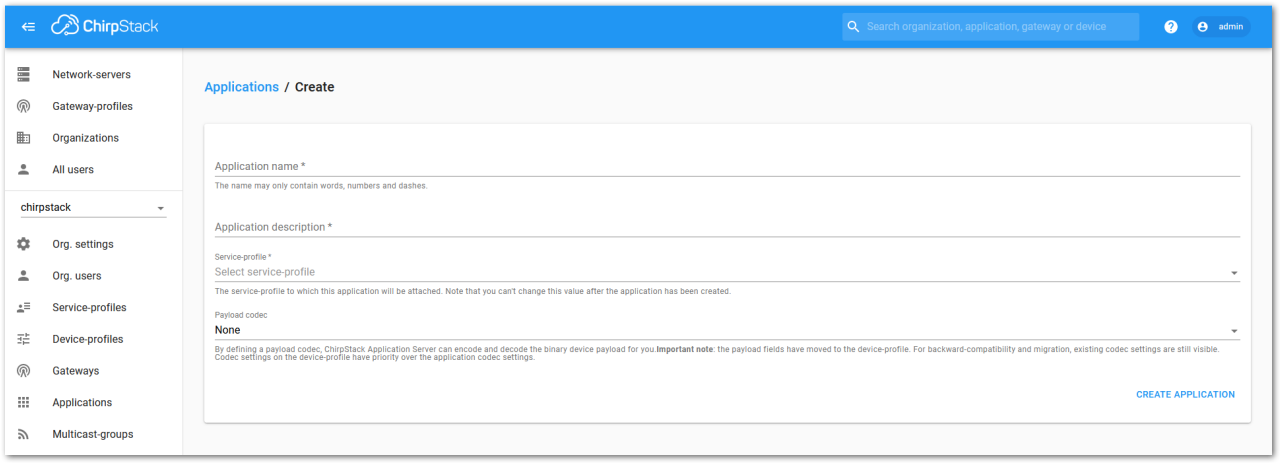 Figure 1: Creating a New Application
Figure 1: Creating a New Application- For this setup, create an Application named “rak_node_test”.
ChirpStack LoraServer supports multiple system configurations, with only one by default.
- Service profile: field is to select the system profile.
- Payload codec: is the parsing method for selecting load data. Such as parsing LPP format data.
 Figure 1: Filling Parameters of an Application
Figure 1: Filling Parameters of an Application-
Choose the Application created in the previous step, then select the DEVICES tab, as shown in Figure 38 and Figure 39.
-
Once done, click “CREATE APPLICATION”.
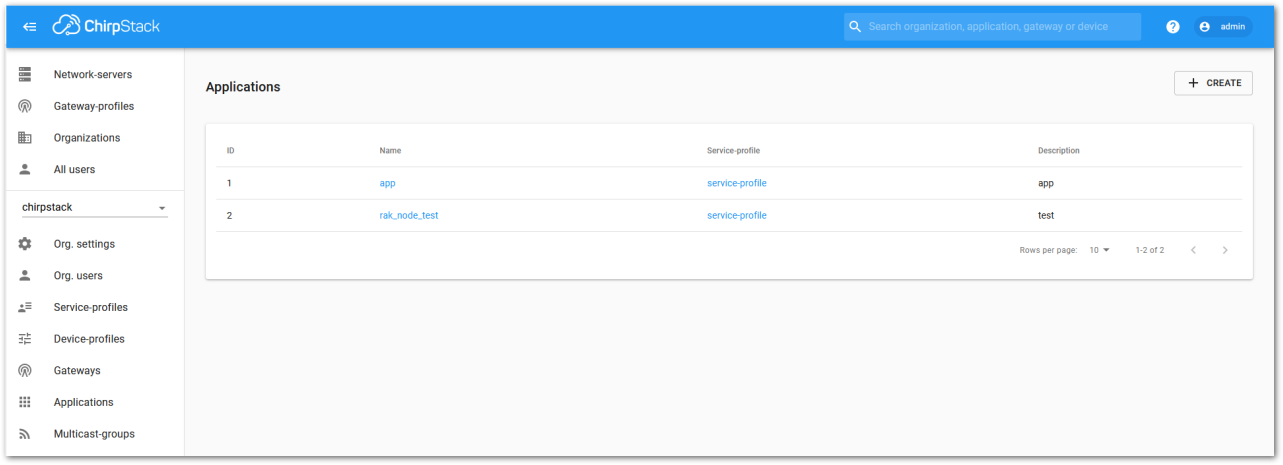 Figure 1: List of Applications Created
Figure 1: List of Applications Created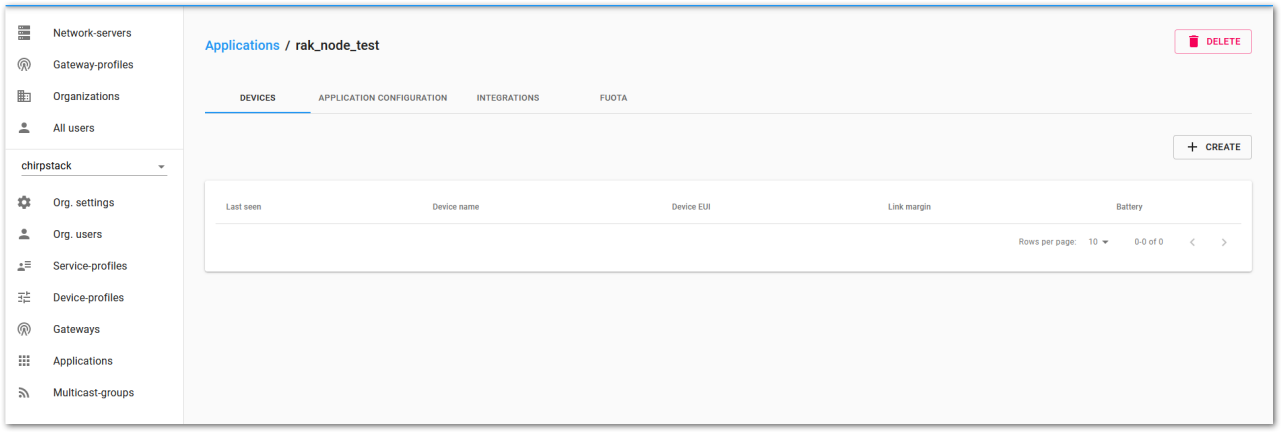 Figure 1: Device Tab of an Application
Figure 1: Device Tab of an Application- Once inside of the DEVICE tab, create a new device (LoRa node) by clicking on the “+ CREATE” button.
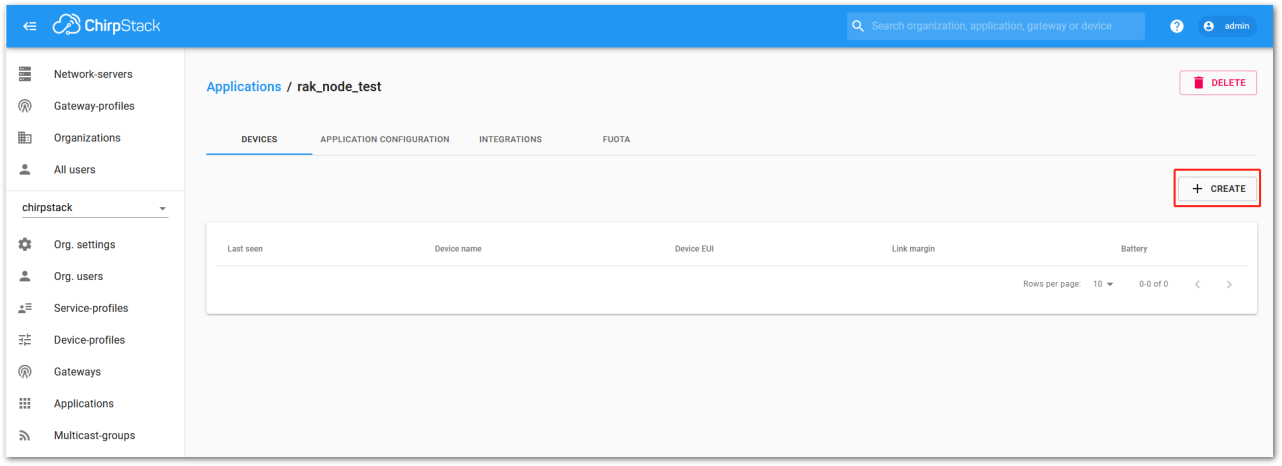 Figure 1: Add a New Device
Figure 1: Add a New Device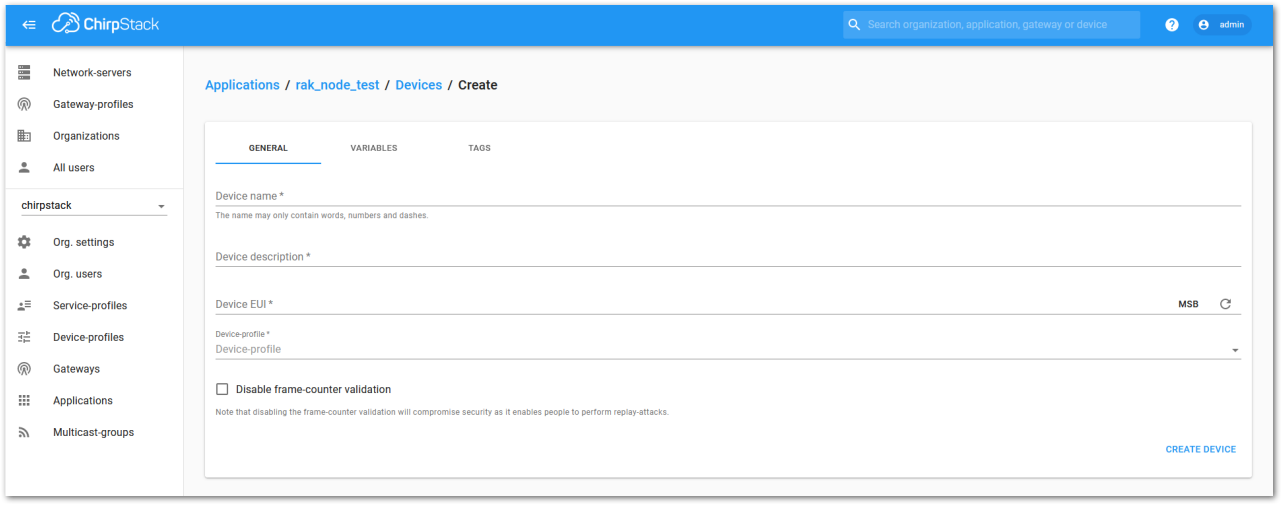 Figure 1: New Device Registration Form
Figure 1: New Device Registration Form- Once the node is created, fill in the necessary data. You can generate a Device EUI automatically by clicking the following icon, or you can write a correct Device EUI in the edit box.
Fill in the parameters requested:
- Device name and Device description: These are descriptive texts about your device.
- Device EUI: This interface allows you to generate a Device EUI automatically by clicking the icon highlighted in red in Figure 42. You can also add a specific Device EUI directly in the form.
- Device Profile:
- If you want to join in OTAA mode, select “DeviceProfile_OTAA”.
- If you want to join in ABP mode, select “DeviceProfile_ABP”.
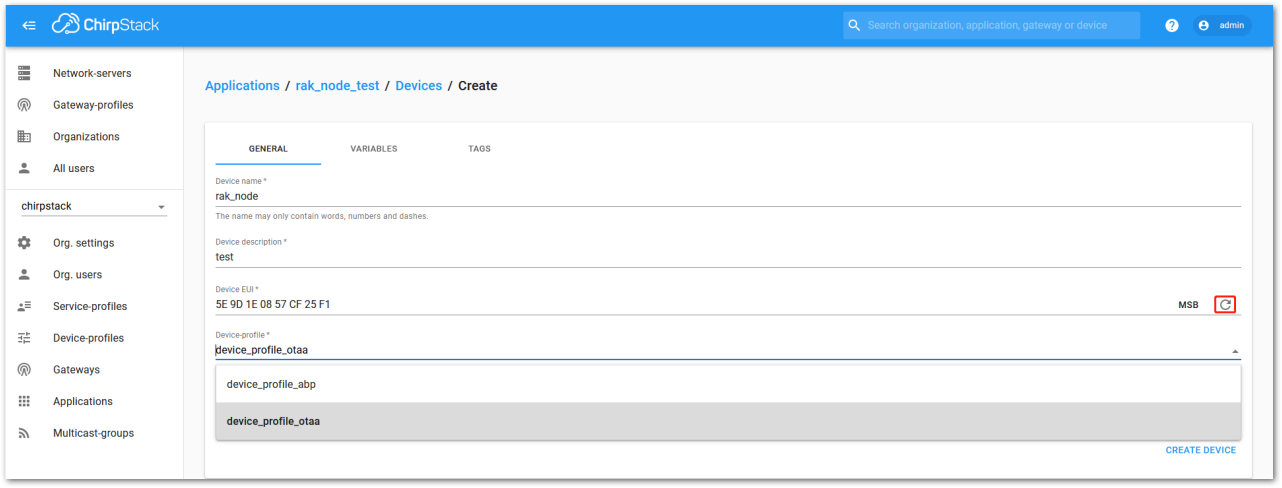 Figure 1: Generate a New Device EUI
Figure 1: Generate a New Device EUILoRaWAN Join Mode
In LoRaWAN, there are two (2) ways a node can connect itself to the LoRaWAN network. This is referred to as Join Mode. LoRaWAN allows the OTAA mode and the ABP mode. In this section, the configuration process of these two modes, both on the platform side and the node side will be explained.
OTAA Mode
Configure the OTAA Mode on the Platform
- If you have selected “DeviceProfile_OTAA”, as shown in Figure 43, then after the device is created, an Application Key must be also created for this device.
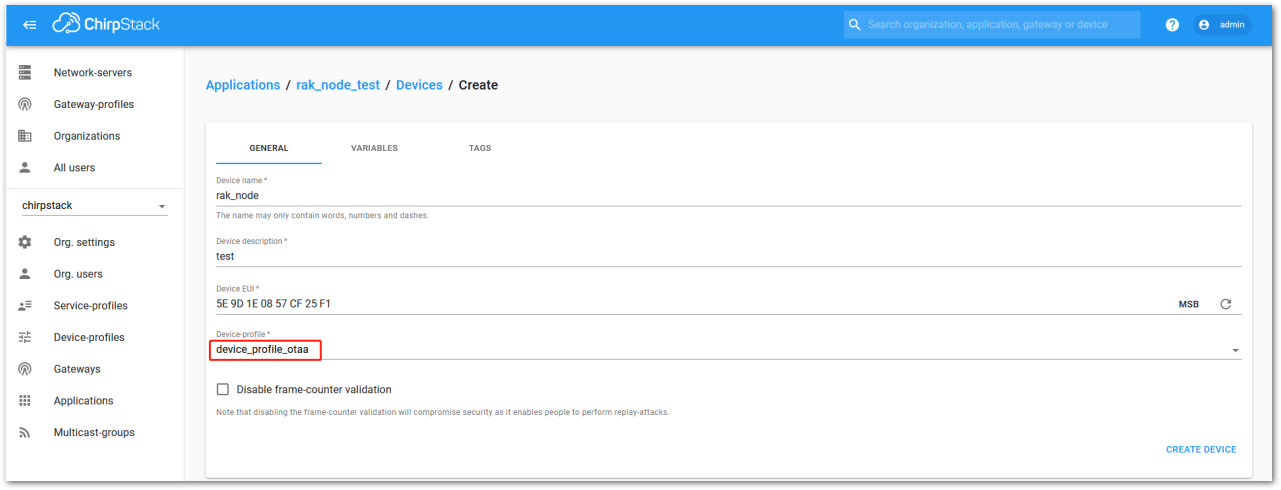 Figure 1: Chirpstack OTAA Activation
Figure 1: Chirpstack OTAA Activation- A previously created Application Key can be entered here, or a new one can be generated automatically by clicking the icon highlighted in red in Figure 44:
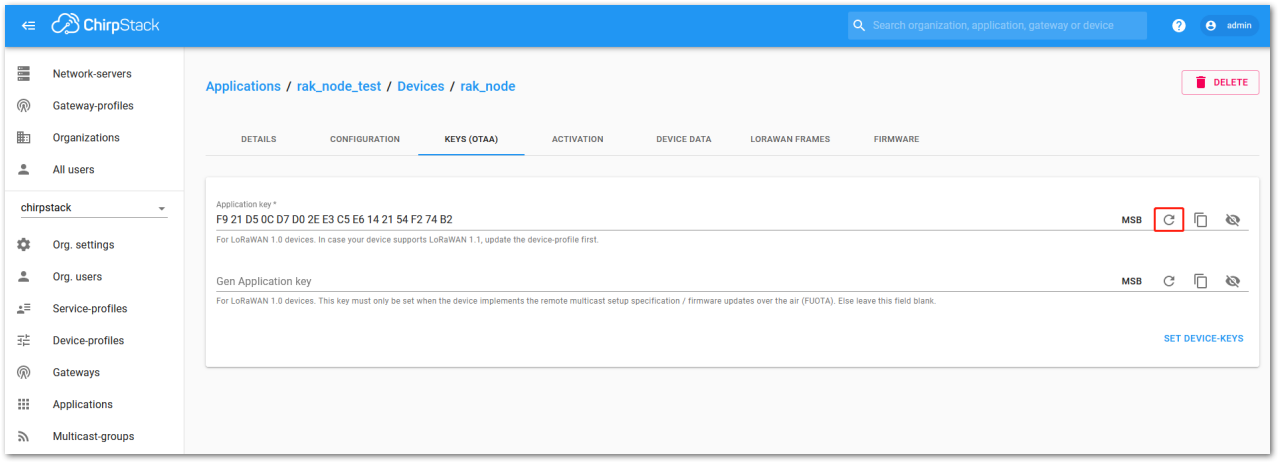 Figure 1: Chirpstack OTAA Set Device Keys
Figure 1: Chirpstack OTAA Set Device Keys- Once the Application Key is added to the form, the process can be finalized by clicking on the “SET DEVICE-KEYS” button.
- As shown in Figure 45, a new device should be listed in the DEVICES tab. The most important parameters, such as the Device EUI, are shown in the summary.
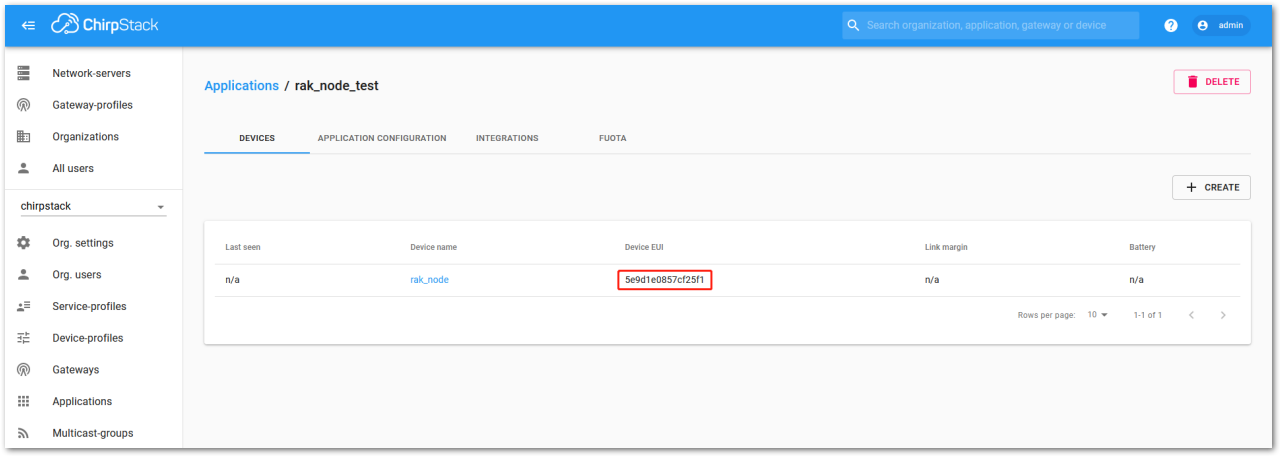 Figure 1: Chirpstack OTAA List of Device in the Device Tab
Figure 1: Chirpstack OTAA List of Device in the Device Tab- To end the process, it is a good practice to review that the Application Key is properly associated with this device. The Application Key can be verified in the KEYS(OTAA) tab, as shown in Figure 46.
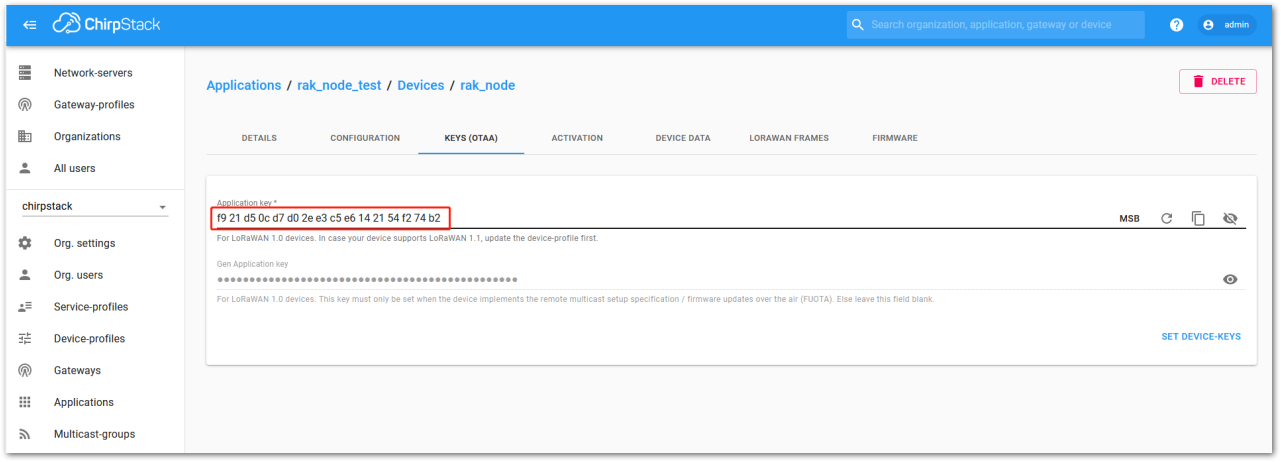 Figure 1: Application Key Associated with the New Device
Figure 1: Application Key Associated with the New DeviceStandard OTAA mode requires the Device EUI, Application Key, and the Application EUI. But in ChirpStack’s implementation, only the Device EUI and the Application Key are mandatory. The Application EUI is not required and is not recorded in the Application tab. Nevertheless, the Application EUI is a mandatory parameter in the RAK4270 module’s firmware. To resolve this mismatch, you can reuse the Device EUI as the Application EUI during the configuration on the side of the node.
Configure the OTAA Mode on the RAK4270
The RAK4270 Module supports a series of AT commands to configure its internal parameters and control the functionalities of the module.
To set up the RAK4270 Module to join ChirpStack using OTAA, start by connecting the RAK4270 Module to the computer (see Figure 1), open the RAK Serial Port Tool, and then wait for the communication to start. It is recommended to test the serial communication by sending either of these two AT commands:
at+get_config=lora:status
at+version
 Figure 1: at+version command response
Figure 1: at+version command responseAs an example, these are the list of the parameters you need to configure in RAK4270:
- LoRa join mode: OTAA
- LoRa class: Class A
- LoRa region: EU868
- Device EUI: 5e9d1e0857cf25f1
- Application EUI: 5e9d1e0857cf25f1
- Application Key: f921d50cd7d02ee3c5e6142154f274b2
- Set the LoRa join mode to OTAA.
at+set_config=lora:join_mode:0
- Set the LoRa class to Class A.
at+set_config=lora:class:0
- Set the frequency/region to EU868.
- Refer to the RAK4270 Module Datasheet for the list of supported frequencies.
at+set_config=lora:region:EU868
- Set the Device EUI.
at+set_config=lora:dev_eui:5e9d1e0857cf25f1
- Set the Application EUI.
at+set_config=lora:app_eui:5e9d1e0857cf25f1
The Application EUI parameter is not required in the ChirpStack platform. Therefore, it is possible to use the same ID as the Device EUI. Otherwise, the firmware will complain.
- Set the Application Key.
- Get the Application Key from the TTN register.
at+set_config=lora:app_key:f921d50cd7d02ee3c5e6142154f274b2
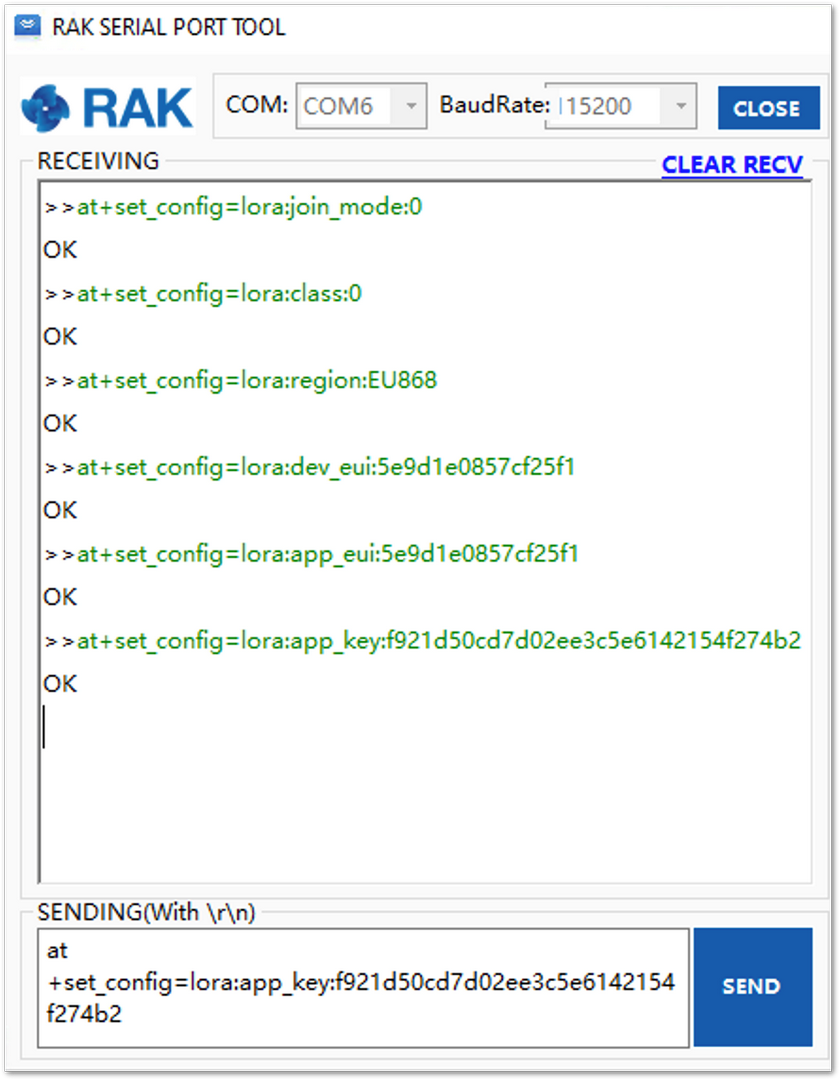 Figure 1: Chirpstack OTAA configuration via RAK Serial Port Tool
Figure 1: Chirpstack OTAA configuration via RAK Serial Port ToolAfter configuring all the parameters, you need to reset your RAK4270 Module to save the parameters.
- After resetting, start to join.
at+join
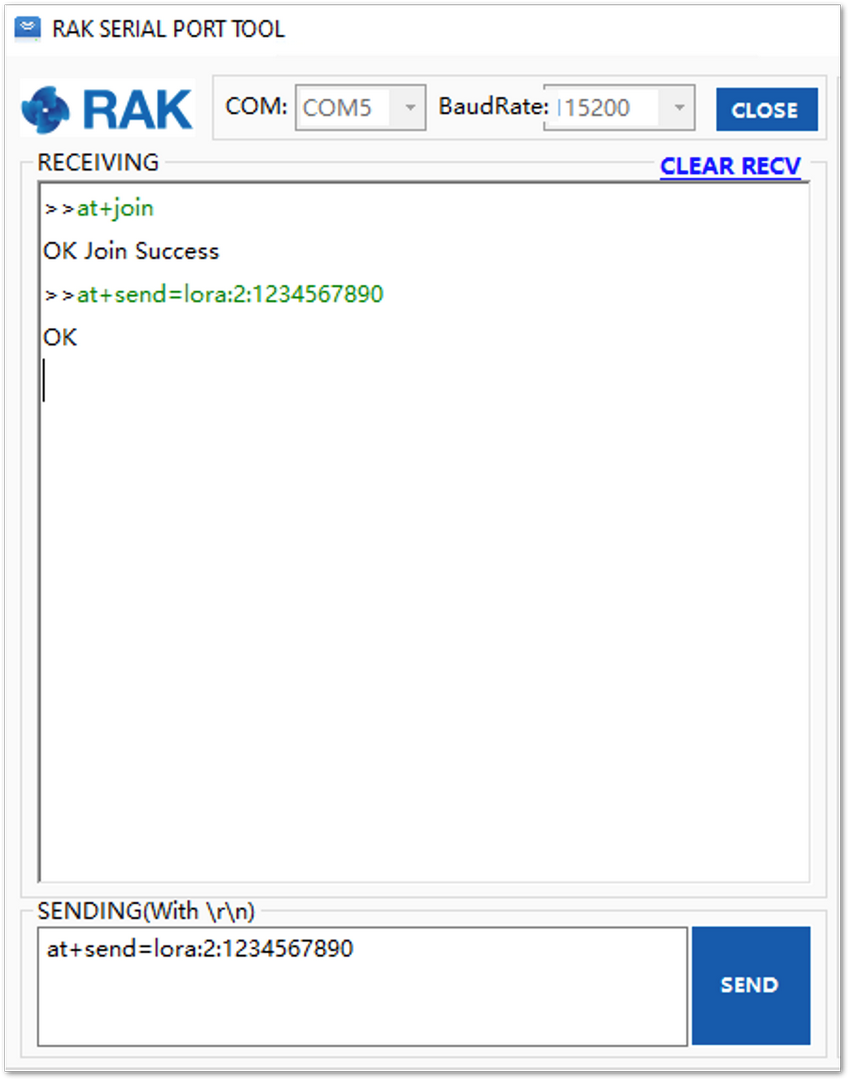 Figure 1: Chirpstack OTAA Join the Network via RAK Serial Port Tool
Figure 1: Chirpstack OTAA Join the Network via RAK Serial Port Tool- You can then see the JoinRequest and JoinAccept on the ChirpStack page.
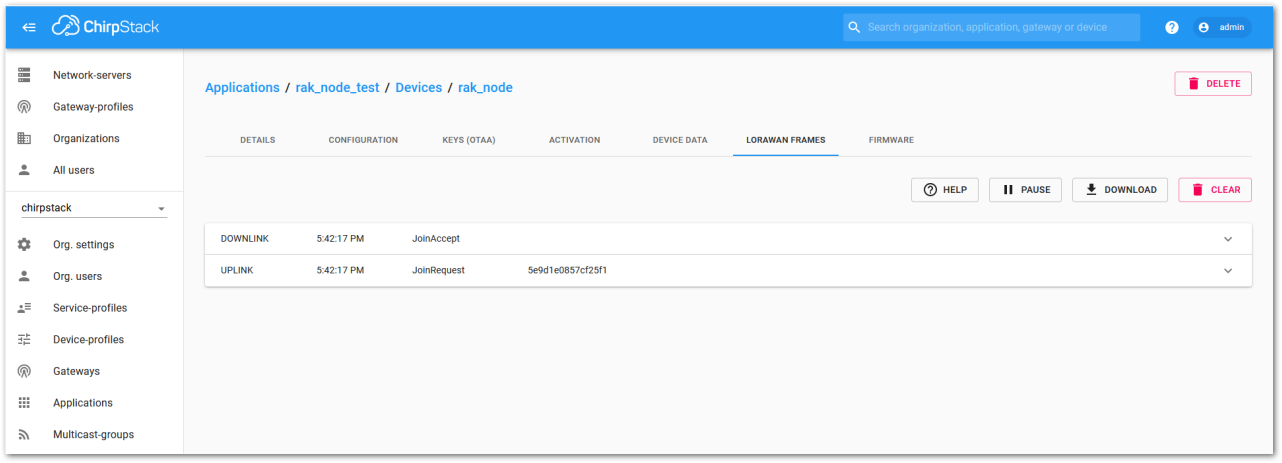 Figure 1: Checking LoRaWAN Joint Request in Chirpstack OTAA Console
Figure 1: Checking LoRaWAN Joint Request in Chirpstack OTAA Console- Now, try to send data from the RAK4270 Module to ChirpStack.
at+send=lora:2:1234567890
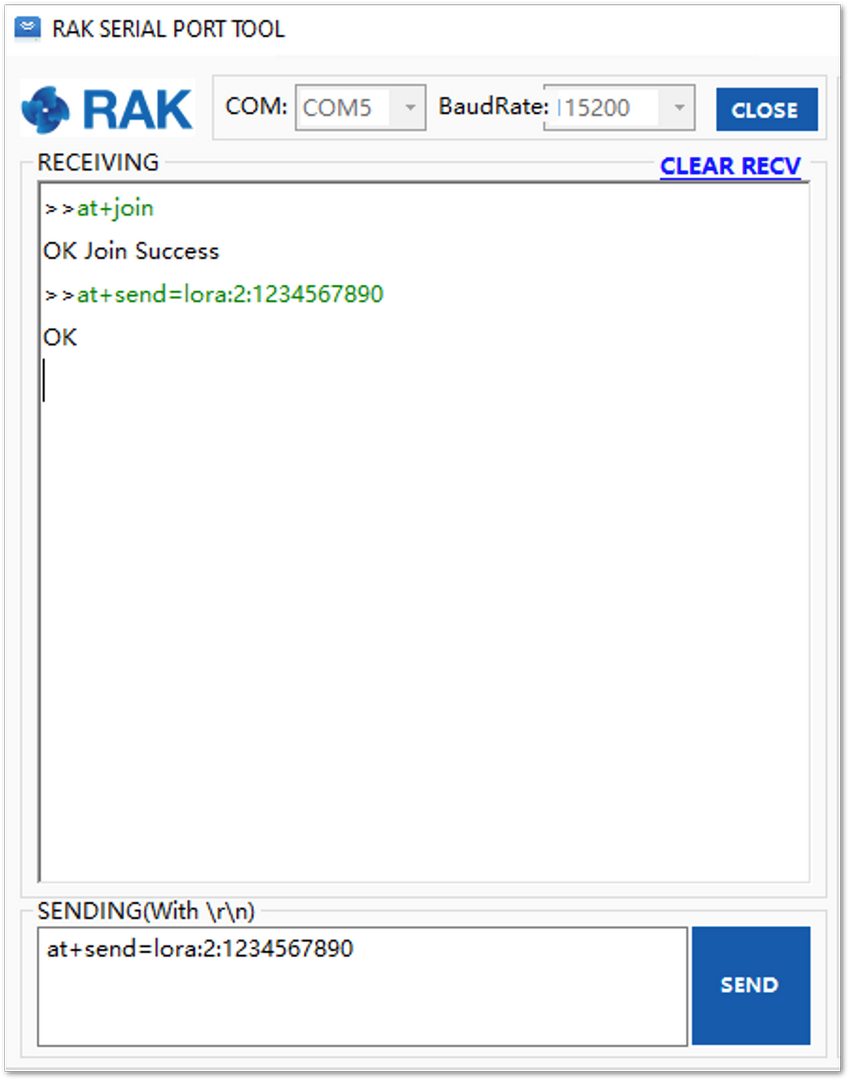 Figure 1: Send a LoRaWAN Message via RAK Serial Port Tool
Figure 1: Send a LoRaWAN Message via RAK Serial Port Tool- On the ChirpStack platform, you should also see the messages in the LORAWAN FRAMES tab, as shown in Figure 52. By convention, messages sent from nodes to gateways are considered as Uplinks, while messages sent by gateways to nodes are considered as Downlinks.
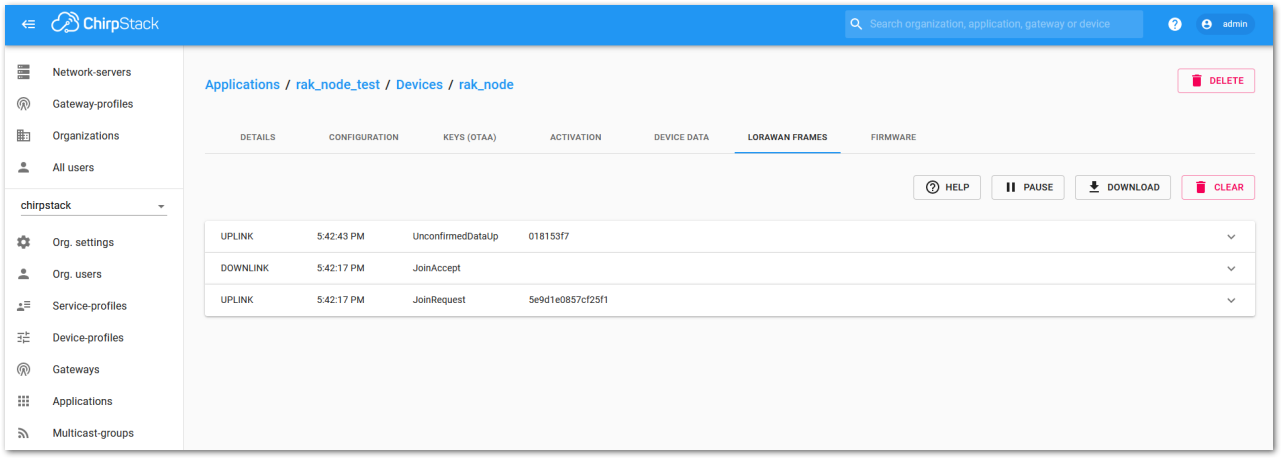 Figure 1: Chirpstack Data Received Preview
Figure 1: Chirpstack Data Received PreviewThis concludes the exercise to send data in the OTAA mode.
ABP Mode
Configure the ABP Mode on the Platform
During the registration of a new device, if you select “DeviceProfile_ABP”, as shown in Figure 53, then the ChirpStack platform will assume that this device will join the LoRaWAN network using the ABP mode.
Check “Disable counting frame verification”. During the test, when the module is restarted, the frame counting number will be also be restarted from zero. This would cause a synchronization problem with the ChirpStack server treating it as a replay attack. For the testing purpose, it is safe to disable this feature, but remember to activate it in a production environment.
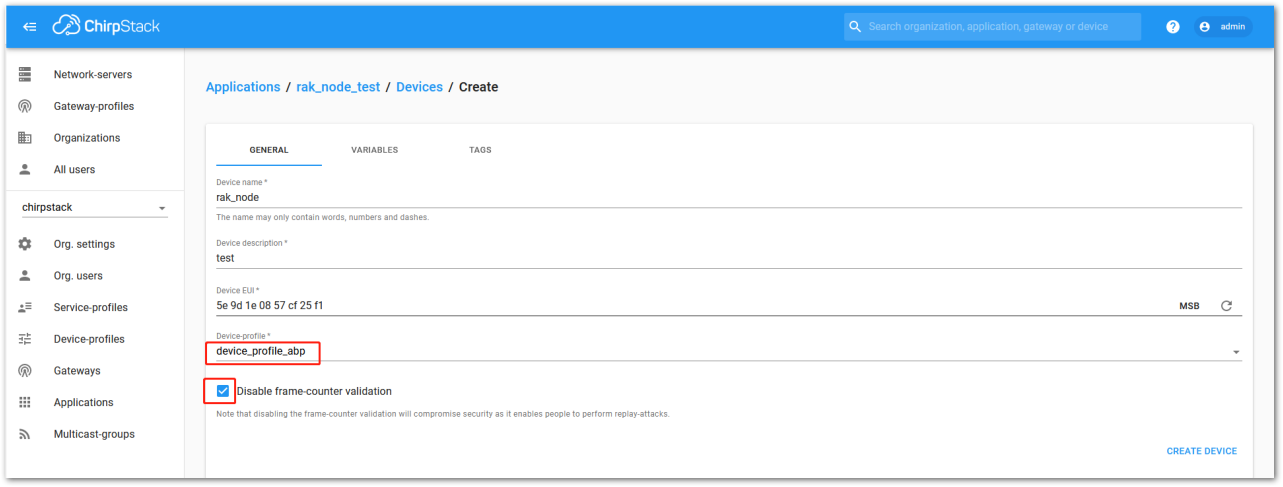 Figure 1: ChirpStack Console, Configuring a Device
Figure 1: ChirpStack Console, Configuring a DeviceAfter selecting the ABP mode, the following parameters appear in the Activation tab:
- Device address
- Network Session Key
- Application Session Key
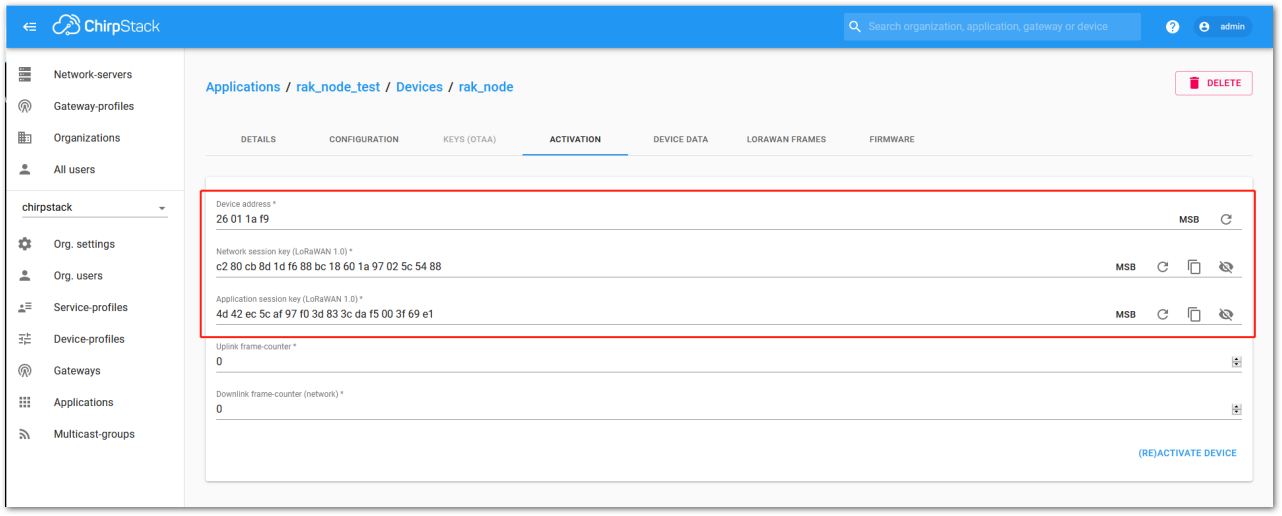 Figure 1: Chirpstack ABP Activation Parameters Needed
Figure 1: Chirpstack ABP Activation Parameters Needed- The parameters can be generated as random numbers by the platform or can be set with user values. Once these parameters are filled in properly, the process is completed by clicking on the “ACTIVATE DEVICE” button.
Configure the ABP mode on the RAK4270
In the following steps, you will configure the RAK4270 Module to work in the ABP mode. To set up the RAK4270 Module to join ChirpStack using ABP, start by connecting the RAK4270 Module to the computer (see Figure 1), open the RAK Serial Port Tool, and then wait for the communication to start. It is recommended to test the serial communication by sending either of these two AT commands:
at+get_config=lora:status
at+version
 Figure 1: at+version command response
Figure 1: at+version command responseAs an example, these are the list of the parameters you need to configure in RAK4270:
- LoRa join mode: ABP
- LoRa class: Class A
- LoRa region: EU868
- Device address: 26011af9
- Network Session Key: c280cb8d1df688bc18601a97025c5488
- Application Session Key: 4d42ec5caf97f03d833cdaf5003f69e1
- Set LoRa join mode to ABP.
at+set_config=lora:join_mode:1
- Set LoRa class to Class A.
at+set_config=lora:class:0
- Set the frequency/region to EU868.
- Refer to the RAK4270 Module Datasheet for the list of supported frequencies.
at+set_config=lora:region:EU868
- Set the Device Address.
at+set_config=lora:dev_addr:26011af9
- Set the Network Session Key.
at+set_config=lora:nwks_key:c280cb8d1df688bc18601a97025c5488
- Set the Application Session Key.
at+set_config=lora:apps_key:4d42ec5caf97f03d833cdaf5003f69e1
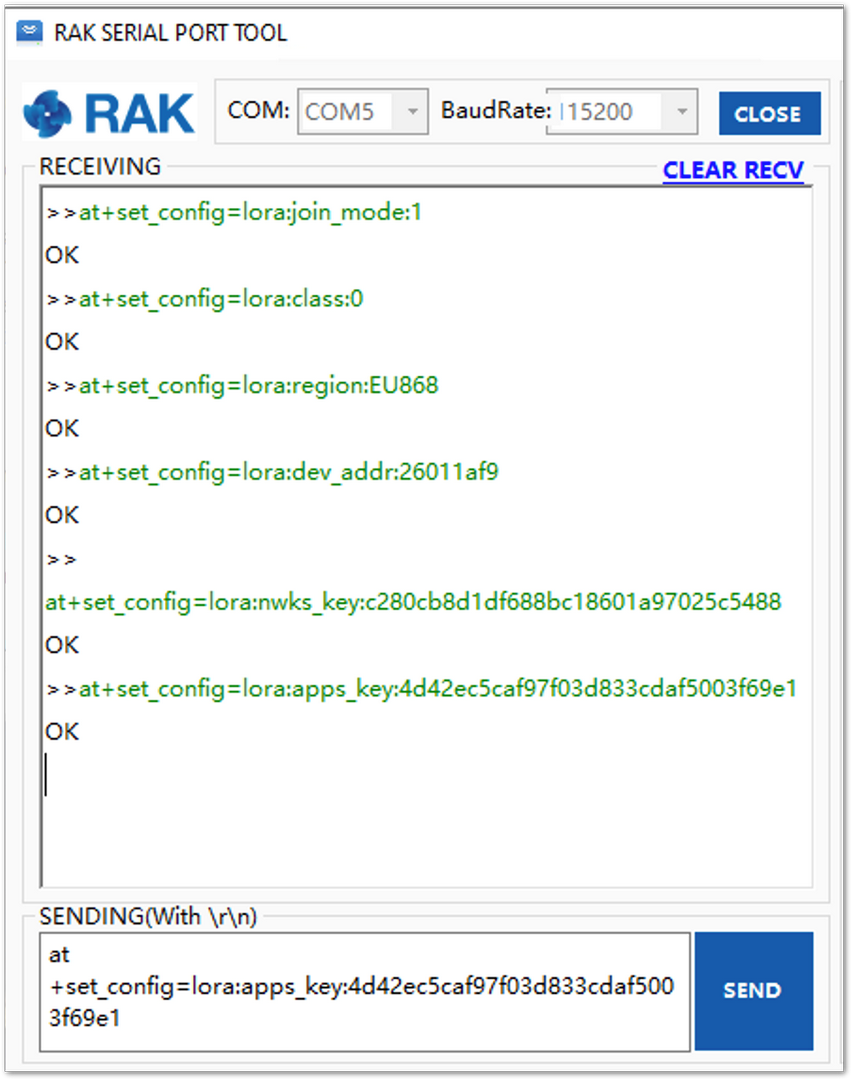 Figure 1: Chirpstack ABP Parameters Configuration via RAK Serial Port Tool
Figure 1: Chirpstack ABP Parameters Configuration via RAK Serial Port ToolAfter configuring all the parameters, you need to reset your RAK4270 Module to save the parameters.
- After resetting the RAK4270 Module, join in ABP mode.
at+join
By using the ABP mode in the LoRaWAN protocol, it doesn’t require to join a network before sending the LoRaWAN package. But to keep the consistency of internal states of the firmware of the RAK4270 Module, it is still required to send the at+join command in the ABP mode. This time, the firmware should reply almost immediately with an “OK”.
- Now, try sending data from the RAK4270 Module to ChirpStack.
at+send=lora:2:1234567890
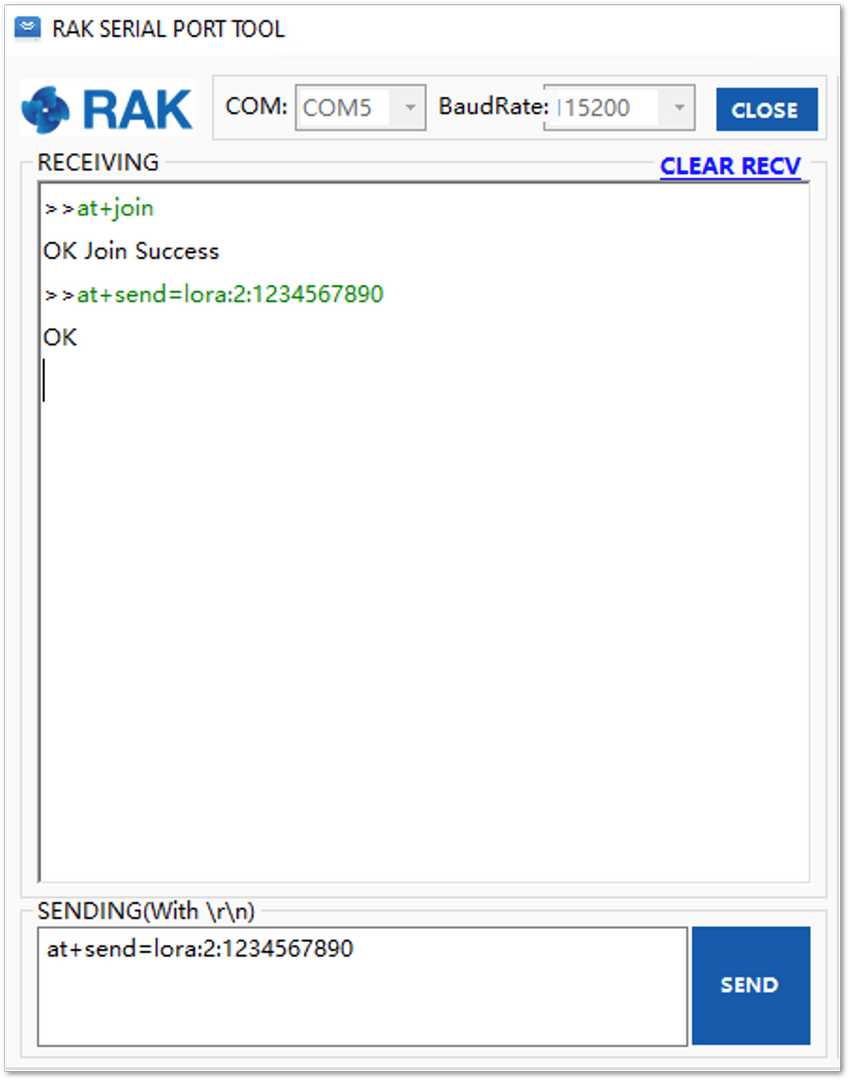 Figure 1: Chirpstack Sample Data Sent via RAK Serial Port Tool
Figure 1: Chirpstack Sample Data Sent via RAK Serial Port ToolLoRa P2P Mode
This section will show you how to set up and connect two RAK4270 units to work in the LoRa P2P mode. You will be using EU868 as your frequency, although it is applicable also to other standard bands.
-
Two RAK4270 units shall be set to operate on EU868 frequency.
-
The setup of the RAK4270 units is done by connecting them with a general-purpose computer through the UART port. The setup of each RAK4270 can be done separately but testing the LoRa P2P mode will require having both units connected simultaneously to their respective UART port. This could be one computer with two (2) USB ports or two (2) computers with one USB port each.
-
Set the RAK4270 to work in LoRa P2P mode. Open the RAK Serial Port Tool and send the following command:
at+set_config=lora:work_mode:1
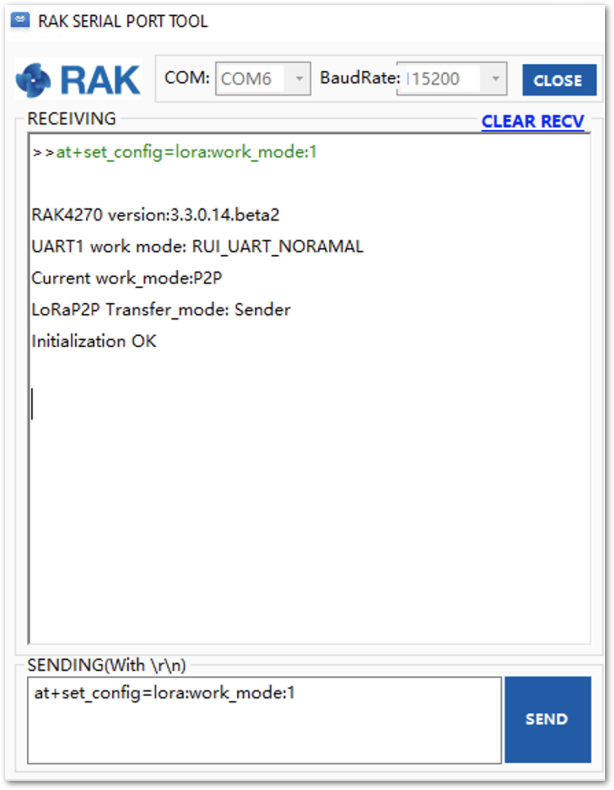 Figure 1: P2P Initialization
Figure 1: P2P Initialization- Then, configure LoRa P2P parameters for both of them.
at+set_config=lorap2p:XXX:Y:Z:A:B:C
For this example, the LoRa parameters are the following:
- Link frequency: 869525000 Hz
- Spreading factor: 7
- Bandwidth: 125 kHz
- Coding Rate: 4/5
- Preamble Length: 5
- Power: 5 dBm
Refer to the Configuring Using AT Commands section to learn more about the definition of the parameters used.
Hence, it is translated into the following RAK4270 AT command and sent to both units.
at+set_config=lorap2p:869525000:7:0:1:5:5
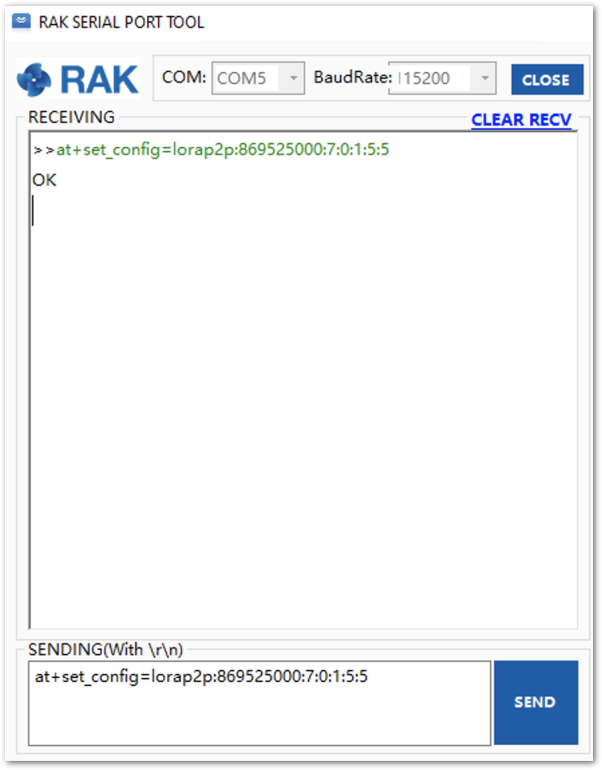 Figure 1: Configuring P2P in both RAK4270 Module
Figure 1: Configuring P2P in both RAK4270 Module- Set the transmission mode of the module. Unit 1 is configured as the sender, and Unit 2 is set to the receiver by AT command.
at+set_config=lorap2p:transfer_mode:2
at+set_config=lorap2p:transfer_mode:1
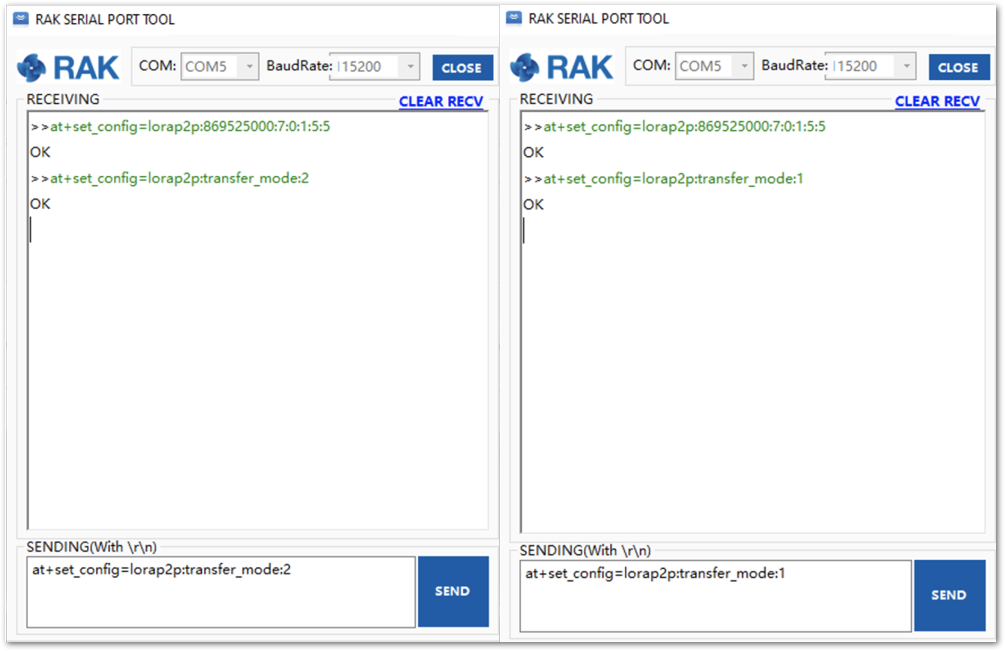 Figure 1: Setting Modes in both RAK4270 Module
Figure 1: Setting Modes in both RAK4270 Module- Try sending a message from Unit 1 to Unit 2.
at+send=lorap2p:1234567890
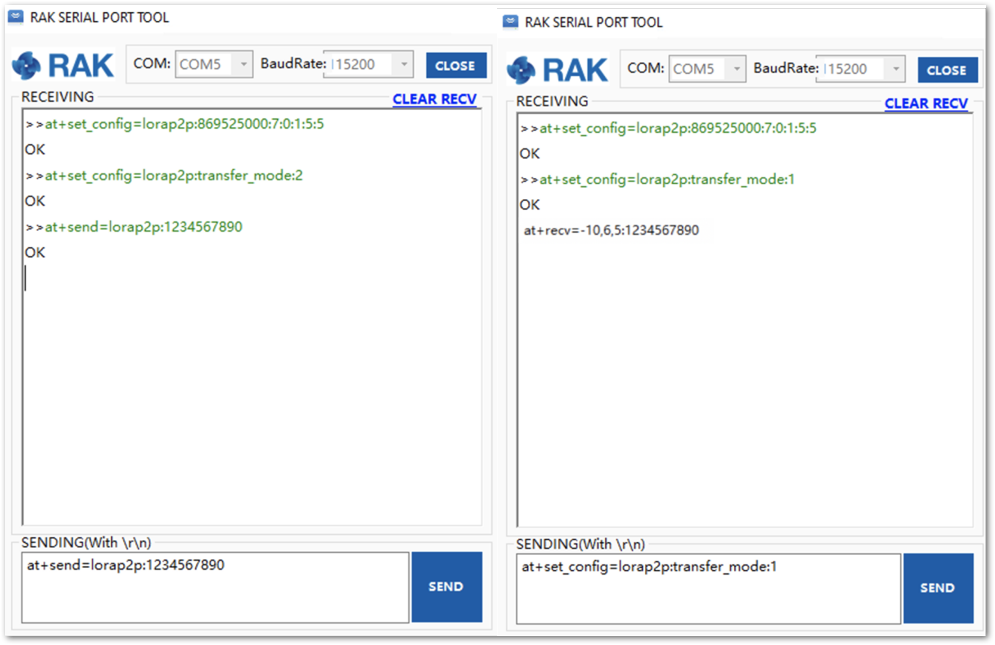 Figure 1: Message sent and received status in the two modules
Figure 1: Message sent and received status in the two modulesMiscellaneous
Upgrading the Firmware
Before you start working with the RAK4270, it is recommended to keep the RAK4270 Module updated to the latest version of the firmware. Download the latest RAK4270 firmware.
For RAK4270 modules with firmware version V3.0.0.12 and below, you need to use the STM32CubeProgrammer to upgrade your firmware and upload the .hex file (not the .bin file) of the latest RAK4270 firmware. The lower versions of the firmware have a different bootloader code and will not work on the RAK DFU Tool.
In the following sections, two (2) options for flashing new firmware in a RAK4270 Module are shown: Upgrade through DAPLink and Upgrade through UART1.
Firmware Upgrade Through DAPLink
Refer to the RAKDAP1 Flash and Debug Tool guide in the Accessories Category.
Firmware Upgrade Through UART1
Minimum Hardware and Software Requirements
Refer to the table for the minimum hardware and software required to perform the firmware upgrade using J-Link.
| Hardware/Software | Requirement |
|---|---|
| Computer | A Windows/Ubuntu/Mac computer |
| Firmware File | Bin firmware file downloaded from the website |
| Others | A USB to TTL module |
Firmware Upgrade Procedure
Execute the following procedure to upgrade the firmware in Device Firmware Upgrade (DFU) mode through the UART1 interface.
-
Download the latest application firmware of the RAK4270 that can be found on the datasheet.
-
Download the RAK Device Firmware Upgrade (DFU) tool.
-
Connect the RAK4270 Module with a computer through a USB to TTL. Refer to Figure 1
-
Open the Device Firmware Upgrade tool. Select the serial port and baud rate of the module and click the "Select Port" button.
 Figure 1: Device Firmware Upgrade Tool
Figure 1: Device Firmware Upgrade Tool- Select the application firmware file of the module with the suffix ".bin".
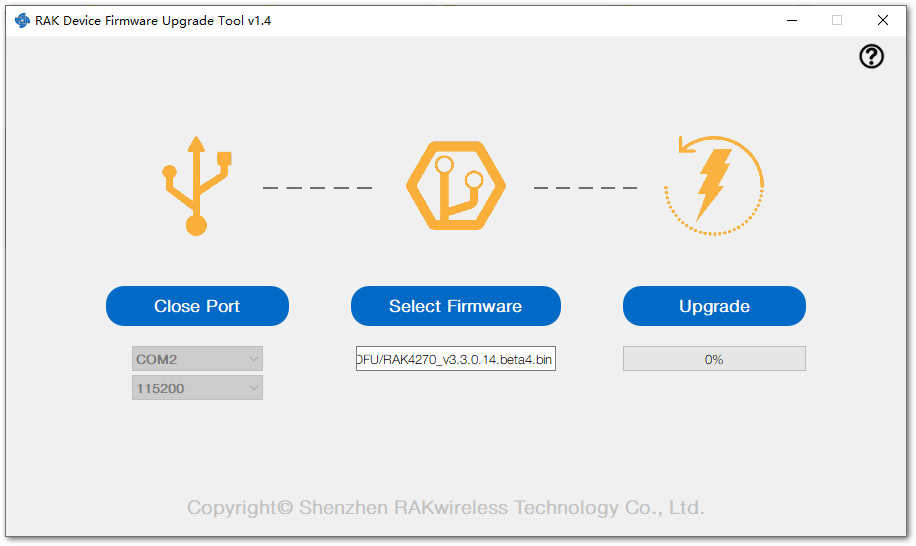 Figure 1: Select Firmware
Figure 1: Select Firmware- Click the "Upgrade" button to upgrade the device. After the upgrade is complete, the RAK4270 Module will be ready to work with the new firmware.
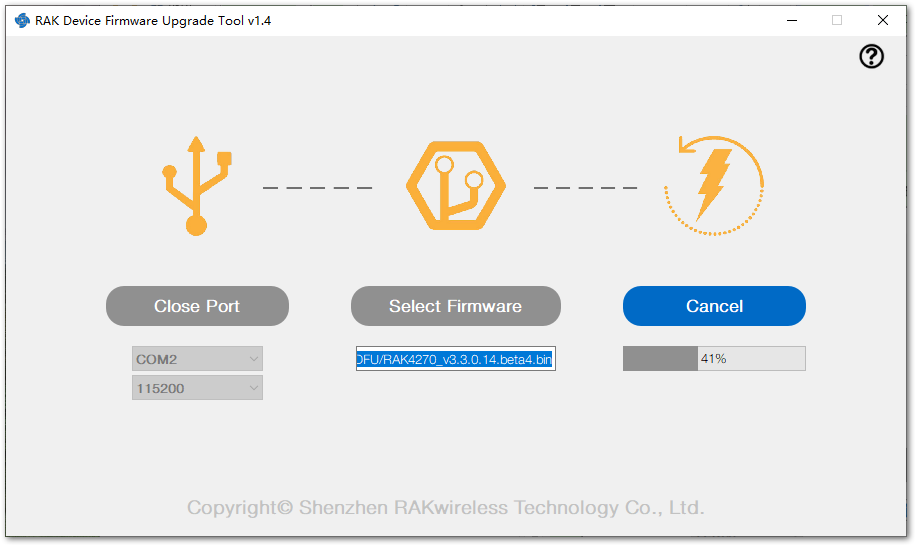 Figure 1: Firmware Upgrading
Figure 1: Firmware Upgrading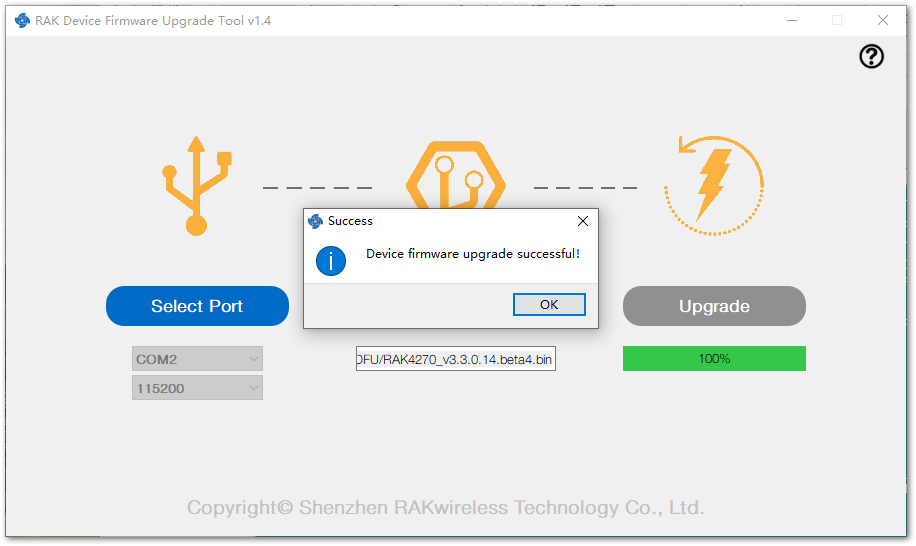 Figure 1: Upgrade Successful
Figure 1: Upgrade Successful